Samsung Electro Mechanics SWL-2100U Wireless LAN Card User Manual class b
Samsung Electro Mechanics Wireless LAN Card class b
Contents
- 1. Manual
- 2. Pages to be added
Manual

360 Herndon Parkway
Suite 1400
Herndon, VA 20170
http://www.rheintech.com
Certification Report For: ICOM America Page 40 of 51
Document Number: 2000453
APPENDIX F: MANUAL
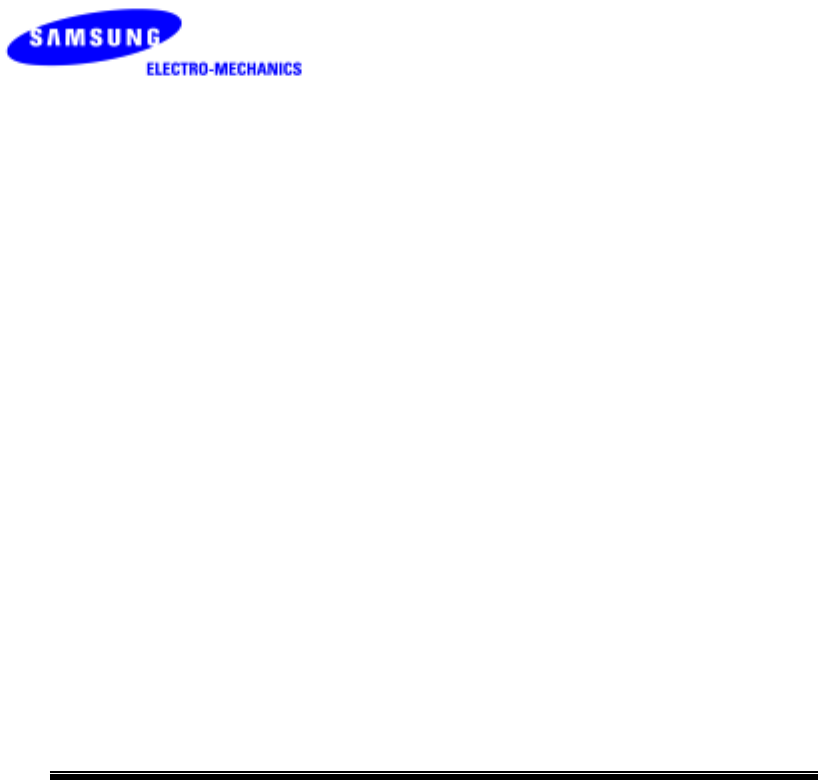
SAMSUNG
MagicLAN
SWL-2000/2100
User Manual

1
Notice 1
This manual cannot be reproduced in any form without the prior written permission of
SAMSUNG Electro-Mechanics Co., Ltd.
SAMSUNG Electro-Mechanics Co., Ltd. reserves the right to change this manual and the
specifications to improve products without prior notice. So you can get the most recent
software and user documentation for all MagicLAN products on our web site.
All other brand and product names are trademarks of registered trademarks of their
respective holders.
http://www.MagicLAN.com
Service Dept.
Youngsik Lyu (youngsik@samsung.co.kr)
Tel : +82-31-289-1043 Fax : +82-31-289-1060
Sales
America
Dae-Ho Yoon (daeho@samsung.co.kr)
Tel : +82-31-289-1154 Fax : +82-31-289-1060
Europe
John Choi (john7@samsung.co.kr)
Tel : +82-31-289-1148 Fax : +82-31-289-1060
Southeast Asia
Chang-Young Jang (chance@samsung.co.kr)
Tel : +82-31-289-1153 Fax : +82-31-289-1060
China
John Choi (john7@samsung.co.kr)
Tel : +82-31-289-1148 Fax : +82-31-289-1060
Japan
John Choi (john7@samsung.co.kr)
Tel : +82-31-289-1148 Fax : +82-31-289-1060
Copyright 1999 - 2001 SAMSUNG Electro-Mechanics Co., Ltd.
All rights reserved.

2
Notice 2
The SWL-2000N/2100N/2100E, SWL-2000P/2100P and SWL-2100U complies with Part
15 of the FCC rules.
Operation is subject to the following two conditions.
(1) This device may not cause harmful interference.
(2) This device must accept any interference received, including interference that may
cause undesired operation.
Note: The SWL-2000N/2100N/2100E, SWL-2000P/2100P and SWL-2100U have been
tested and found to comply with the limits for a Class B digital device and a low power
transmitter, according to Part 15 of the FCC Rules. These limits are designed to provide
reasonable protection against harmful interference in a residential installation. This
equipment generates, uses and can radiate radio frequency energy and, if not installed and
used in accordance with the instructions, may cause harmful interference to radio
communications. However, there is no guarantee that interference will not occur in a
particular installation. If this equipment does cause harmful interference to radio or
television reception, which can be determined by turning the equipment off and on, the user
is encouraged to resolve the problem by one or more of the following measures;
- Reorient or relocate the receiving antenna.
- Increase the separation between the equipment and the receiver.
- Connect the equipment to an output on a circuit different from that to which the receiver is
connected.
- Consult the dealer or an experienced radio/TV technician for help.

3
Important Safety Information
!"
Read these simple guidelines. Breaking the rules may be dangerous or illegal. SAMSUNG will
not be responsible for any damages caused by breaking the rules.
!"
WLAN Card described in this document is approved for use in a wireless local area network.
!"
Remember to make backup copies of important data.
!"
Samsung WLAN PC Card supports 3V(3.3V) Notebook computers.
!"
When you are transferring data, keep your laptop computer stationary. Roaming between
access points (APs) may break the connection.
!"
Only qualified service personnel must repair the equipment.
!"
All wireless devices may get interference, which could affect performance.
!"
Use approved accessories only. Do not connect incompatible products.
!"
Use only accessories approved by the WLAN Card manufacturer for use with this particular W
LAN Card. The use of any other types will invalidate any approval or warranty applying to the
WLAN Card, and may be dangerous.
!"
Use only the region settings appropriate for the area where the WLAN Card is used at the
present time. Using the card in any other region or with an incorrect region setting is prohibited
and may be illegal.
!"
Operation of any radio transmitting equipment, including a WLAN Card, may cause
interference with the functionality of inadequately protected medical devices.
!"
Do not use the WLAN Card on aircraft.
!"
Do not use the WLAN Card at a refueling point.
!"
Do not use the WLAN Card near inflammable materials or chemicals.
!"
Do not use the WLAN Card where blasting is in progress.
!"
Do not use the WLAN Card when the use of wireless device may cause interference or danger.
!"
Do not use the WLAN Card where the use of cellular terminals is prohibited.
!"
Microwave oven degrades the performance of wireless LAN drastically. So do not use the
WLAN card in the environment where Microwave oven is being used.

4
Specifications
Product
Name SWL-2000N SWL-2100N SWL-
2000P
SWL-
2100P
SWL-
2100E SWL-2100U
General
Type PC Card Type II PCI 2.0 2MMCX
Connector
Printed
Dipole Ant
Open
Space
100m
(330ft) at
11Mbps
150m
(500ft) at
2 Mbps
150m
(500ft) at
11Mbps
200m
(660ft) at
2 Mbps
100m
(330ft) at
11Mbps
150m
(500ft) at
2 Mbps
150m
(500ft) at
11Mbps
200m
(660ft) at
2 Mbps
150m
(500ft) at
11Mbps
200m
(660ft) at
2 Mbps
150m
(500ft) at
11Mbps
200m
(660ft) at
2 Mbps
Cover-
age
Area
**
Closed
Office
20m
(65ft) at
11Mbps
40m
(130ft) at
2 Mbps
30m
(100ft) at
11Mbps
50m
(160ft) at
2 Mbps
20m
(65ft) at
11Mbps
40m
(130ft) at
2 Mbps
30m
(100ft) at
11Mbps
50m
(160ft) at
2 Mbps
30m
(100ft) at
11Mbps
50m
(160ft) at
2 Mbps
30m
(100ft) at
11Mbps
50m
(160ft) at
2 Mbps
Operating
Voltage 3V +/- 5% 5V +/- 5% 3V +/- 5% 5V fromPC
Current
consumption
Tx: Max
320mA
Rx: Max
200mA
Tx: Max
450mA
Rx: Max
280mA
Tx: Max
320mA
Rx: Max
200mA
Tx: Max
450mA
Rx: Max
280mA
Tx: Max
450mA
Rx: Max
280mA
Tx: Max
450mA
Rx: Max
280mA
Data Rates 1,2,5.5, and 11Mbps
Certifications
FCC Class B, FCC part 15.247, Canada, CE, Germany, Swiss,
England, other Europe Countries and New R&TTE Approval,
Korea, Japan
Security WEP 64/128 bits encryption(40/104bits encryption)
Warranty 1 Year
Network Specifications
Network architecture Ad-hoc, infrastructure
Wireless standard IEEE 802.11b
Operating System
Win 95(OSR2)***, Win 98SE(98), Win ME, Win NT***,
Win 2k , Win CE(only supported by PC Card)***, Linux***
Win XP (to be supported)
Roaming IEEE 802.11 compliant with enhanced roaming features
Radio Data
Frequency band FCC, Canada, ETSI, Spain, France and Japan****
Wireless medium Direct Sequence Spread Spectrum
Modulation techniques CCK, BPSK, QPSK
Sensitivity Min. –80dBm at 2Mbps/ Min. –78dBm at 11Mbps
Output power
Max
20mW
Typical
13dBm
Max
70mW
Typical
17dBm
Max
20mW
Typical
13dBm
Max
70mW
Typical
17dBm
Max
70mW
Typical
17dBm
Max
70mW
Typical
17dBm

5
Environmental Specifications
Temperature 0
°C to 40 °C in operation/ -20 °C to 70 °C in storage
Humidity 95% non-condensing
Physical Characteristics
Dimension 113.8 × 54 × 6
(mm)
113.8 × 54 ×
6 (mm)
148 × 90 ×
16 (mm)
148 × 90 × 16
(mm)
85.6 × 54 × 6
(mm)
114 × 52 ×
15 (mm)
Weight 39g 39g 95g 95g 40g 40g
Optional Antenna
Patch Antenna, 3″ / 5″ Stub Antenna, Yagi Antenna Available
**The operating environment may affect coverage
*** Not to be supported by USB (Win CE, Linux will be supported soon)
**** Table: The Operating Channels
Channel# Frequency FCC Canada ETSI Spain France Japan
1 2412MHz
○
○○
○ ○
○○
○ ○
○○
○
○
○○
○
2 2417MHz
○
○○
○ ○
○○
○ ○
○○
○
○
○○
○
3 2422MHz
○
○○
○ ○
○○
○ ○
○○
○
○
○○
○
4 2427MHz
○
○○
○ ○
○○
○ ○
○○
○
○
○○
○
5 2432MHz
○
○○
○ ○
○○
○ ○
○○
○
○
○○
○
6 2437MHz
○
○○
○ ○
○○
○ ○
○○
○
○
○○
○
7 2442MHz
○
○○
○ ○
○○
○ ○
○○
○
○
○○
○
8 2447MHz
○
○○
○ ○
○○
○ ○
○○
○
○
○○
○
9 2452MHz
○
○○
○ ○
○○
○ ○
○○
○
○
○○
○
10 2457MHz
○
○○
○ ○
○○
○ ○
○○
○ ○
○○
○ ○
○○
○ ○
○○
○
11 2462MHz
○
○○
○ ○
○○
○ ○
○○
○ ○
○○
○ ○
○○
○ ○
○○
○
12 2467MHz
○
○○
○ ○
○○
○ ○
○○
○
13 2472MHz
○
○○
○ ○
○○
○ ○
○○
○
14 2484MHz
○
○○
○

6
Table of Contents
1. MagicLAN Installation ……………...………..……………………………………...…...8
1.1 Introduction ..………..…………………...……………………………………….…..8
1.2 Technical Background ………………………………………………..……….…..…8
1.3 MagicLAN Overview….…………………...……………….….……….…..……....10
2. Before the Installation ………………………………………………………..……….....12
2.1 What is in your Package …………………………………………………….….…..12
2.2 System Requirement ……………………………………..…………………….…...12
3. MagicLAN Installation for Windows 95/98 …………….…………. ……………….….13
3.1 Installation Overview ……………………………………….……………….……...13
3.2 Installation Procedure of SWL-2000N/2100N/2100E PC Card …………….…..….13
3.3 Installation Procedure of SWL-2000P/2100P PCI Card …………………...……….14
3.4 Installation Procedure of SWL-2100U USB Card…………….…………………….16
3.5 Uninstallation Method ………………….……………………….….…….…….......17
4. MagicLAN Installation for Windows NT 4.0 ………………………..……………...….18
4.1 Installation Procedure of SWL-2000N/2100N/2100E PC Card ….……...…………18
4.2 Installation Procedure of SWL-2000P/2100P PCI Card ……………………....……20
4.3 Uninstallation Method …………………………………….………….…….………22
5. MagicLAN Installation for Windows 2000.………………………..……….……...……23
5.1 Installation Procedure of SWL-2000N/2100N/2100E PC Card ……………………23
5.2 Installation Procedure of SWL-2000P/2100P PCI Card …………………………....24
5.3 Installation Procedure of SWL-2100U USB Card…………………………………..24
5.4 Uninstallation Method………………………………………………………………26
6. MagicLAN Installation for Windows CE……….……………………………………….27
7. MagicLAN Installation for Linux…………………………..………………………..…..28
7.1 Installation procedure of SWL-2000N/2100N/2100E PC Card……………....…….28
7.2 Installation procedure of SWL-2000P/2100P PCI Card…………………………….35
8. The Program for setting MagicLAN..…….………………………...………..………..…42
8.1 The concept of Profile………………………………………….………..……….….42
8.2 Installation Procedure………………………………………………………...….….43
9. The main configuration of Program………………………..……….….………………..49
7
9.1 Profile………………………………………………...……………………………...51
9.1.1 The ‘New’ button………….……………………………………..…….……...51
9.1.2 The ‘Apply’ button…………..……………………………………...………...51
9.1.3 The ‘Edit’ button…………..………………………………………………..…51
9.1.4 The ‘Delete’ button………..……………………………………………....…..53
9.2 Status…………………………………………………………….……….…..…...…54
9.2.1 The ‘Current Status’ button……….…………………………………...…......54
9.2.2 The ‘AP Status’ button..….…….…………….………………………..……..55
9.2.3 The ‘Site Survey’ button………………….….………………………...……..56
9.2.4 Statistics………………...………..………………...…….….……....………..56
9.3 General Settings……………….………..……………...….……………..…..….…..57
9.3.1 The ‘DHCP’ button…….…………….……………………………….…..….57
9.3.2 The ‘Options’ button…………………….……………………….……….….57
9.4 Version………………………………………………………….……………..…….58
10. Troubleshooting ………………………………………………......…….……….…….59
10.1 Procedure to Check the Various Properties of Card after Installation………………..59
10.2 Probable Symptoms and their Diagnosis…………………………………....………..62

8
1. MagicLAN Installation
1.1 Introduction
Thank you for your purchase of SAMSUNG MagicLAN. This new Adapter series includes
two different models: SWL-2000N/2100N/2100E for PC Card-compatible computers,
SWL-2000P/2100P for PCI-compatible computers and SWL-2100 for USB-compatible
computers. Installing those cards allow the computer to join a wireless network based on
the IEEE 802.11b (High Data Rate) WLAN standard. You will be surprised how easy for
you are a part of the network with no bother of twisted cables.
1.2 Technical Background
• What is IEEE 802.11?
The IEEE 802.11 specification is a wireless LAN standard developed by the IEEE (Institute
of Electrical and Electronic Engineering) committee in order to specify an over an air
interface between a wireless client and a base station or Access Point (AP), as well as
among wireless clients. Like other IEEE 802 families, IEEE 802.11 specification addresses
both Physical (PHY) layer and Media Access Control (MAC) layer.
• IEEE 802.11 Physical (PHY) Layer
At the PHY layer, IEEE 802.11 defines three physical characteristics for WLAN: diffused
infrared, direct sequence spread spectrum (DSSS), and frequency hopping spread spectrum
(FHSS). While the infrared PHY operates at the baseband, the other two PHYs operate at
the 2.4GHz ISM (Industrial, Scientific, and Medical) band, which can be used for operating
wireless LAN devices without the need of end-user licenses. In order for wireless devices to
be interoperable, they have to be conforming to the same PHY standard.
• IEEE 802.11 Media Access Control (MAC) Layer
The IEEE 802.11 MAC Layer is mainly concerned with the rules for accessing the wireless
medium. There are two network architectures defined: Ad-hoc Network and Infrastructure
Network.
• Ad-hoc Network
Ad-hoc Network is an architecture that supports mutual communication among wireless
clients only. Since Ad-hoc Network does not support access to wired networks, it does not
need an Access Point to be a part of the network. You can use the network immediately
after setting up the operating mode by installing the supplied network driver.
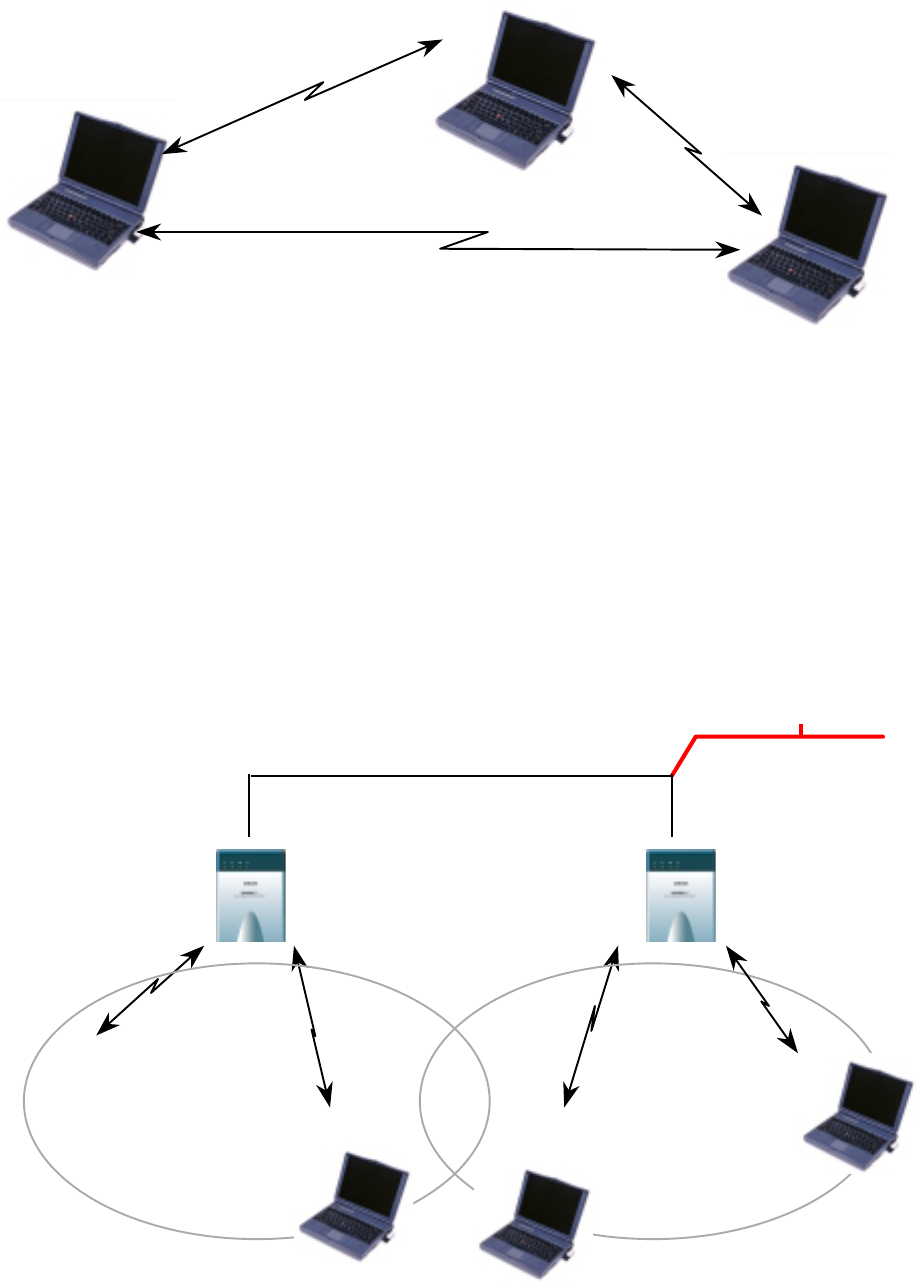
9
• Infrastructure Network
Infrastructure Network is architecture that provides communication between wireless
clients and wired network resources. An Access Point (AP) and the associated wireless
clients define the transition of data. So a wireless client can access all the services that are
available for a regular wired LAN by using an AP.
BSS A
BSS ABSS A
BSS A
BSS B
BSS BBSS B
BSS B
Serve
r
Server

10
• Roaming
Roaming is a service that allows wireless clients to use the network in motion by
automatically changing the connection from an old Access Point to a new Access Point
when the clients enter in a new cell. During roaming the clients may observe the loose
connection or delay in accessing the resources of the network.
• Scanning, Beaconing & ESS ID
When a wireless client is initialized, it is necessary for it to find and communicate with the
correct group of wireless devices, including AP. At this point, it may search for all the
frequency channels and this process is called scanning.
There may be multiple APs and networks operating at the same time. It may be necessary to
ensure that the station joins with the correct network during the scanning process. To
achieve this, each AP is assigned to be part of a logical group called the Extended Service
Set (ESS). The name of this logical group is the ESS ID. When roaming is operating, there
may be several Access Points as part of the same ESS.
After the power on, wireless clients will listen on its default frequency channel. It will be
listening for beacons sent by another wireless station or AP. Beacon is a short message
containing the ESS ID that will be broadcast roughly ten times a second. When the wireless
station hears a beacon and the ESS ID in the beacon matches its own, the client knows that
it is on the correct channel and can communicate with its group. If no beacons are seen, or if
the ESS ID does not match, the wireless client may move to the next frequency channel and
repeat this listening procedure.
In case of direct sequence spread spectrum (DSSS) physical layer, this scanning process
occurs at start up and may also occur when the client roams between APs.
1.3 MagicLAN Overview
• The MagicLAN SWL-2000P/2100P (for Desktop PCs), SWL-2000N/2100N/2100E (for
Notebook PCs) and SWL-2100U(for Desktop PCs and Notebook PCs) are wireless LAN
adapter cards that provide wireless connection between computers.
• The MagicLAN is designed to operate with IEEE 802.11 (wireless LAN International
Standard) wireless compliant radio cards and uses a CSMA/CA (Collision Sense Multiple
Access with Collision Avoidance) algorithm as the media access scheme, which makes high
speed communication (with minimal collision probability) possible.

11
• The MagicLAN supports DSSS (Direct Sequence Spread Spectrum) physical layer. This
is a radio technique, which scrambles the data prior to transmission and uses a correlation
technique on receiver to improve the signal to noise ratio and makes it possible to
communicate in the office having a wall and a compartment.
• The function of the MagicLAN Access Point is to transfer information from a wired LAN
to a wireless LAN and vice versa. When operating, the MagicLAN AP is invisible to most
users (Normally, unless the user is an administrator, the MagicLAN AP cannot be seen or
accessed by users on the network).
• The SWL-2000N/2100N/2100E for Notebook PC is small and portable as a roaming
function is provided for users who need network services while maintaining mobility.
• The MagicLAN Adapter (only PC Card) has an LED (Light Emitting Diode) on the part
of the card. The yellow LED will illuminate when the power is supplied and the card is
inserted properly.
• The MagicLAN supports various network software. The network driver is provided to
support network software such as Windows 95(OSR2), Windows 98/98SE,ME, Windows
NT 4.0, Windows 2000, Windows CE, Linux (cf. Win 95(OSR2) and Windows NT 4.0
are not supported by USB Card)
• The Caution of using the SWL-2000P/2100P
1. Make the Antenna of WLAN PCI Card and WLAN PC Card of AP in same direction.
2. The efficiency of communication can be improved by regulating the direction of
WLAN PCI Card and AP.
• The Caution of using the SWL-2100U
Some problems may occur when you use the other USB equipments, such as PC Camera,
scanner, etc, with the USB Card.
• To get further information of Samsung MagicLAN WLAN Card, please visit our website
at http://www.magiclan.com to download the respective drivers.

12
2. Before the Installation
The following section will assist you in installing your WLAN Adapter successfully. You
will first install software (driver) and then will insert the SWL-2000P/2100P, SWL-
2000N/2100N/2100E or SWL-2100U WLAN card, and finally set the network properties to
accommodate resource sharing and select the type of wireless network that you wish to
install. The MagicLAN can easily be installed and used, without bothering to connect
cables for keeping your computer to use network resources, as in case of a wired LAN.
2.1 What is in Your Package?
Please check the contents of the box to make sure everything is included and ready for use.
Here is the list of what you should have in your package:
• SWL-2000N/2100N/2100E (PC Card), SWL-2000P/2100P(PCI Card) or SWL-
2100U(USB Card)
• SWL-2000X Installation CD
• External Antenna (for SWL-2000P/2100P only)
2.2 System Requirement
• Operating System: MS Windows 95(OSR2)/98/98SE,ME, Windows NT 4.0, Windows
2000, Windows CE, Linux
• Computer System (both Notebook and Desktop) with a CD-ROM drive
• For Desktop PC Adapter Card (SWL-2000P/2100P):
The computer system should have an extra IRQs and I/O address.
• For Notebook PC Adapter Card (SWL-2000N/2100N/2100E):
The computer system should have PCMCIA Type II or Type III card slot.
Important: In case of using 3V PC Card, notebook PC must support 3V(3.3V) Card. If
you are not aware of this issue, please contact your dealer. Some old Notebook PCs may
not support 3.3V Card.

13
3. MagicLAN Installation for Windows 98/98SE/ME
There are two types of WLAN Cards i.e. PC Card and PCI Card for Notebook PC and
Desktop PCs respectively. Here we explain the procedure of installing both cards under
Windows 98/98SE/ME operating system (OS) one by one (to be also supported by
Windows 95(OSR2)). We will explain the installation method for SWL-
2000N/2100N/2100E PC Card followed by the installation method for SWL-
2000P/2100P PCI Card and SWL-2100U USB Card .
3.1 Installation Overview
Here are some steps you will perform in establishing your wireless network connection:
• Install the Access Point at first. AP is needed in case of Infrastructure network mode.
• Install the software using the Installation CD.
• Now you should install the Wireless LAN Card (SWL-2000N/2100N/2100E or
SWL-2000P/2100P or SWL-2100U).
• Install the network protocol(s) required to communicate on your network. Most
likely you will need the TCP/IP protocol.
3.2 Installation Procedure of SWL-2000N/2100N/2100E PC Card
Please follow the following steps one by one in order to install the PC Card successfully.
1. Power on your computer and allow Windows 98/98SE/ME to load fully.
2. Be sure that there is no PC Card adapter inserted yet.
3. Insert the given Installation CD in the CD-ROM. Select the Software Installation
from the menu and then click on the Install.
4. Select the
Windows PC Card and PCI Card Driver from the menu then the Setup
Program will be installed automatically.
5. Accept the
license agreement.
6. Give the path of the destination folder. To set the path of your choice click Browse
and then click Next.
7. Select the type of card. As you are preparing to install the PC Card, select the SWL-
2000/2100(PC Card type) and click on Next.
8. It takes a few seconds for copying the utility files and then click on Finish to
complete the installation.

14
9. Insert the
PC Card. Illuminating LED and Sound confirms the detection of your
PC card. Also you will see the PC Card icon on the right bottom of your screen.
10. Restart your computer and a message window pops up saying New Hardware
Found
11. It takes a few seconds in setting up the driver for the new hardware .
12. Check for the SAMSUNG 11Mbps WLAN PC Card 3V/5V by right clicking on
My Computer using the mouse. Select the Device manager and then Network
Adapters. If you find the Yellow sign on the adapter, it shows the installation is not
successful. Select the adapter and click on Remove. Restart your computer after
uninstalling (See the Uninstallation method in section 3.4) the driver to make the
changes effective. And refer to the Troubleshooting at the end of the manual.
13. Right click on the Network Neighborhood using the mouse.
14. Select Properties from the pop up menu. The network box appears and you see
three main tabs: Configuration, Identification and Access Control.
15. Click on the Configuration tab and then click on the Add button. Select Network
Component Type box appears. Click on the Protocol then click the Add button.
16. Select Network Protocols box appears. From the list of manufactures, click on
Microsoft. From the list of network protocols list, select IPX/SPX, then click OK.
17. IPX/SPX protocol is now installed. After clicking on OK return back to Network
Component Type box.
18. Repeat the step 16 and 17 to add TCP/IP protocol.
19. If you want, you can install the NetBEUI protocol.
20. Click on the TCP/IP and set the IP address value, Gateway value, DNS value for
your computer. After setting these parameters appropriately, click OK to return to
Network Component Type and you can select the File and Printer Sharing options
as well as the Access to your computer by other users connected to that network by
setting the computer sharing options. Click on OK.
21. Screen message do you want to restart your Computer will pop up. Select Yes. It
will shut down your computer and will restart.
22. After rebooting your computer, you can set up WLAN Utility Program provided
previously. Refer to chap 6 in this manual.
3.3 Installation procedure of SWL-2000P/2100 PCI Card
Please follow the following steps one by one to install the PCI card successfully.
1. Power on your computer.
2. Be sure that there is no PCI card inserted yet.
15
3. Insert the
Installation CD. Select the Software Installation from the menu and
click on Install.
4. Select the
Windows PC Card and PCI Card Driver from the menu then
Setup Program will be installed automatically.
5. Accept the
license agreement.
6. Give the path of the destination folder. Click on NEXT.
7. Select the type of card as SWL-2000/2100(PCI Card Type) and click on
NEXT.
8. Click on
Finish to complete the software installation.
9. Switch off your computer and insert the PCI Card in the PCI slot.
10. Restart your computer and a message window pops up saying New Hardware
Found.
11. It takes a few seconds in setting up the driver for the new hardware.
12. Check for the SAMSUNG 11Mbps WLAN PCI Card by clicking on the
Device manager. If you find the Yellow sign on the adapter, it shows the
installation is not successful. Select the Adapter and click on Remove. Restart
your computer after uninstalling (See the Uninstallation method in section 3.4)
the driver. And refer the troubleshooting at the end of manual.
13. Right click on the Network Neighborhood using the mouse.
14. Select Properties from the pop up menu. The network box appears and you see
three main tabs: Configuration, Identification and Access Control.
15. Click on the configuration tab and then click on the add button. Select Network
Component Type box appears. Click on the Protocol then click the Add button.
16. Select Network Protocols box appears. From the list of manufactures, click on
Microsoft. From the list of network protocols list, select IPX/SPX, then click
OK.
17. The IPX/SPX protocol is now installed. After clicking on OK return back to
Network Component Type box.
18. Repeat the steps 16 and 17 to add TCP/IP protocol.
19. If you want, you can install the NetBEUI protocol.
20. Select the TCP/IP option for setting the IP address value, gateway value and
DNS value of your computer. After setting these parameters appropriately, click
OK to return to Network Component Type and you can select the File and
Printer Sharing options as well as the access to your computer by other users
connected to that network by setting the appropriate options.
21. Screen message ‘Do you want to restart your Computer’ will pop up. Select
Yes. It will shut down your computer and will restart.
22. After rebooting your computer, you can set up WLAN Utility Program provided
previously. Refer to chap 6 in this manual.

16
3.4 Installation procedure of SWL-2100U USB Card
Please follow the following steps one by one to install the USB card successfully
1. Power on your computer.
2. Insert the
Installation CD. Select the Software Installation from the menu and
click on Install.
3. Select the
Windows USB Card Driver from the menu then Setup Program
will be installed automatically.
4. Accept the
license agreement.
5. Give the path of the destination folder. Click on NEXT.
6. Click on
Finish to complete the software installation.
7. Insert the
USB Card. Illuminating LED and Sound confirms the detection of
your USB card. Also you will see the USB Card icon on the right bottom of your
screen
8. A message window pops up saying New Hardware Found.
9. It takes a few seconds in setting up the driver for the new hardware .
10. Check for the SAMSUNG 11Mbps WLAN USB Card by clicking on the
Device manager. If you find the Yellow sign on the adapter, it shows the
installation is not successful. Select the Adapter and click on Remove. Restart
your computer after uninstalling (See the Uninstallation method in section 3.4)
the driver. And refer the troubleshooting at the end of manual.
11. Right click on the Network Neighborhood using the mouse.
12. Select Properties from the pop up menu. The network box appears and you see
three main tabs: Configuration, Identification and Access Control.
13. Click on the configuration tab and then click on the add button. Select Network
Component Type box appears. Click on the Protocol then click the Add button.
14. Select Network Protocols box appears. From the list of manufactures, click on
Microsoft. From the list of network protocols list, select IPX/SPX, then click
OK.
15. The IPX/SPX protocol is now installed. After clicking on OK return back to
Network Component Type box.
16. Repeat the steps 14 and 15 to add TCP/IP protocol.
17. If you want, you can install the NetBEUI protocol.
18. Select the TCP/IP option for setting the IP address value, Gateway value and
DNS value of your computer. After setting these parameters appropriately, click
OK to return to Network Component Type and you can select the File and
Printer Sharing options as well as the access to your computer by other users
connected to that network by setting the appropriate options.
19. Screen message do you want to restart your Computer will pop up. Select

17
Yes. It will shut down your computer and will restart.
20. After rebooting your computer, you can set up WLAN Utility Program
provided previously. Refer to chap 6 in this manual.
3.5 Uninstallation Method:
If you want to uninstall the PC Card/PCI Card/USB Card under Windows 95(OSR2),
Windows 98/98SE,ME, click the MagicLAN Utility Uninstall from the start button on the
desk bar. Check on the Remove all MagicLAN Software and Click the Next button.
UninstallShield removes the software successfully.
(cf. If you want to just remove the WLAN Card from the PC, Click the ‘Stop SAMSUNG
11Mbps WLAN PC Card/PCI Card/USB Card’ on the right bottom of your computer
screen. Then you remove the WLAN Card after clicking the OK button on the message,
‘SAMSUNG 11Mbps WLAN PC Card/PCI Card/USB Card device can now be safely
removed from the system’)

18
4. MagicLAN Installation for Windows NT 4.0
4.1 Installation procedure of SWL-2000N/2100N/2100E PC Card
Important: Some notebook computers for Win NT 4.0 operating system that do not
support 3V cards will not install your 3V PC Card successfully. You are advised to install
the driver for PC Card Controller available from set manufactures or install the
CardWizard program that will enable the notebook computers supporting 5V cards to
support 3V cards also and will install your PC Card successfully.
Please follow the following steps one by one to install the PC Card successfully. There are
two cases: one is when there is no Windows NT networking Installed and the other is when
the Windows NT networking is installed.
When Windows NT networking is not installed yet:
1. Power on your PC and allow the Windows NT to load fully.
2. Now insert the
Installation CD. Select the software Installation and click on
Install. Then if you click on the ‘Windows PC Card and PCI Card driver’, the
MagicLAN Setup Program will start to install.
3. When there is no Windows NT networking installed yet. You should install your
driver manually. To do so, click on start in task bar, go to Settings and then to
Control Panel.
4. Under
Control Panel, double click on Network icon.
5. Since there is no Windows NT networking installed yet, you will be asked if you
want to install NT networking first. Click on Next and then you will be asked how
will you access the network: modem or LAN. Check the proper selection and click
on next. In network setup wizard box, click on select from list button.
6. In
Select Network Adapter box click on Have Disk button.
7. In
Insert Disk box, you may be asked to specify the necessary software directory.
Insert the MagicLAN Installation CD into the CD-ROM drive. Type in D:\nt40
(Where D is the CD-drive of your Notebook) in the blank and click on OK.
8. In
Select OEM Option box, you will see Samsung 11Mbps WLAN PC Card/
Samsung 11Mbps WLAN PCI Card and select the correct card type and click on
OK.
9. You confirm the Samsung 11Mbps WLAN PC Card.
10. Select the network protocols by clicking on the Protocols. And click on TCP/IP.
11. In the next box to choose network services to use, make sure that all the services
you want to use are checked and click on Next.
19
12. In the next box it is confirmed that necessary NT networking components are
selected. Click on Next. When you are asked to specify the directory that the
necessary NT files are copied from; Insert your Windows NT CD and type in
D:\i386 in the location blank.
13. Some files from the D:\i386 directory are copied and you may be prompted the
same box to ask you to specify where NT files are once more.
14. Since it is looking for some files from the installation CD, insert your installation
CD in CD drive and type D:\nt40 in the blank location and click on continue.
15. SAMSUNG 11Mbps WLAN Card setup box may appear. Set each parameter (I/O
Address, Interrupt) for the proper system configuration set up and other parameters
(network mode, ESS ID, and Tx Rate) for the proper LAN card configuration. If the
resource allocation or I/O addresses conflicts with other devices, change the I/O
address or Interrupt using the Windows NT Diagnostic program.
16. Next box will say network installation is done and network is ready to start. Click
on Next.
17. If you select the DHCP option for TCP/IP, you do not need to set the values. If you
select the Static option, enter the IP value, Subnet masking, Gateway, and DNS
values respectively and then click on OK.
18. If you want, you can install the NetBEUI protocol.
19. Now it is ready for installing networking. Click on NEXT.
20. You can assign the Workgroup/ Domain name. And click on NEXT.
21. Click on the Finish and it will ask you whether you want to restart your computer or
not. Click on Yes.
22. Insert the PC Card in the PC Card slot and restart your computer so that the
changes may be placed in effect.
23. If your computer does not detect the PC Card WLAN Card or the card is not
functioning properly, refer to the Troubleshooting at the end of the manual.
When Windows NT networking is installed already:
1. Power on your computer.
2. Now insert the
Installation CD. Select the Software Installation and click on
Install. Then if you click on the ‘Windows PC Card and PCI Card driver’, the
MagicLAN Setup Program will start to install.
3. Right click on the Network Neighborhood using the mouse and select Properties.
4. Select the
Adapter. And click on Add.
5. Since it is looking for the driver files, enter the path name D:\nt40 (where D is the
CD drive of your Notebook PC) and click on Have Disk. It copies the driver files.
You will see Samsung 11Mbps WLAN PC Card/ Samsung 11Mbps WLAN

20
PCI Card and select the correct card type and click on OK.
6. Configure Wireless LAN Card box may appear. Set each parameter (I/O base,
Interrupt) for the proper system configuration set up and other parameters (network
mode, ESS ID, and Tx rate) for the proper LAN card configuration.
7. Click on
Bindings.
8. Click on the Protocol to access the network and share the resources.
9. Select
TCP/IP and you can select either DHCP or Static for the IP address. If you
select DHCP, you do not need to specify the IP address. If you select the Static
option, enter the IP value, Subnet masking, Gateway, and DNS values
respectively. Also add the Workgroup/ Domain name
10. If you want, you can add the optional protocols such as NetBEUI.
11. After you add the TCP/IP protocol, it will ask you whether you want to restart your
computer or not. Click on Yes to make the changes effective and insert the PC
Card in the PCMCIA slot. Now your network is established successfully, if your
PCMCIA card is detected. If you encounter some problems during installation or
your card is not functioning properly, please refer to the Troubleshooting at the end
of the manual.
4.2 Installation procedure of SWL-2000P/2100P PCI Card
Please follow the following steps one by one to install the PCI card successfully. There are
two cases: when there is no Windows NT networking Installed and the other when the
Windows NT networking is installed.
When Windows NT networking is not installed:
1. Power on your PC on and allow the Windows NT to load fully.
2. Now insert the Installation CD. Select the software Installation and click on
Install. Then if you click on the ‘Windows PC Card and PCI Card driver’, the
MagicLAN Setup Program will start to install.
3. Shut down your computer and insert the PCI card in the PCI slot and restart your
computer.
4. Since there is no Windows NT networking installed yet. You should install your
driver manually. To do so, click on start in task bar, go to Settings and then to
Control Panel.
5. Under
Control Panel, double click on Network icon.
6. Since there is no Windows NT networking installed yet (If you have already
installed Windows NT networking, jump to the step 13 directly), you maybe asked
21
if you want to install NT networking first. Click on Next and then you will be asked
how will you access the network: modem or LAN. Check the proper selection and
click on next. In network setup wizard box, click on select from list button.
7. In
Select Network Adapter box click on Have Disk button.
8. In
Insert Disk box, you may be asked to specify the necessary software directory.
Insert the MagicLAN Installation CD into the CD-ROM drive. Type in D:\nt40
(Where D is the CD-drive of your Notebook) in the blank and click on OK.
9. In
Select OEM Option box, you will see Samsung 11Mbps WLAN PC Card/
Samsung 11Mbps WLAN PCI Card and select the correct card type and click on
OK. You confirm the Samsung 11Mbps WLAN PCI Card.
10. Select the network protocols by clicking on the Protocols. And click on TCP/IP.
11. In the next box to choose network services to use, make sure that all the services
you want to use are checked and click on Next.
12. In the next box it is confirmed that necessary NT networking components are
selected. Click on Next. When you are asked to specify the directory that the
necessary NT files are copied from, insert your Windows NT CD and type in
D:\i386 in the location blank.
13. Some files from the D:\i386 directory are copied and you may be prompted the
same box to ask you to specify where NT files are once more.
14. Since it is looking for some files form the installation CD, insert your installation
CD in CD drive and type D:\nt40 in the blank location and click on continue.
15. Configure WLAN Card box may appear. Set each parameter (I/O base) for the
proper system configuration set up and other parameters (network mode, ESS ID,
and Tx rate) for the proper LAN card configuration.
16. TCP/IP installation message will pop up. Select NO for DHCP.
17. If you select the DHCP option for TCP/IP, you do not need to set the values. If you
select the Static, enter the IP value, Subnet masking, Gateway, and DNS values
respectively and then click on OK.
18. Binding properties will pop up. Click on NEXT.
19. If you want, you can install the NetBEUI protocol.
20. Now it is ready for installing networking. Click on NEXT.
21. Networking is confirmed. Click on NEXT.
22. You can assign Workgroup/ Domain name. And click on NEXT.
23. Click on the Finish and it will ask you whether you want to restart your computer or
not. Click on Yes.
24. If your PCI card is not detected or not functioning properly, please refer to
Troubleshooting at the end of the manual.

22
When Windows NT networking is already installed:
1. Power on your computer.
2. Now insert the
Installation CD. Select the Software Installation and click on
Install. Then if you click on the ‘Windows PC Card and PCI Card driver’, the
MagicLAN Setup Program will start to install.
3. Shut down your computer and insert the PCI card and restart your computer.
4. Right click on the Network Neighborhood using the mouse and select Properties.
5. Select the
Adapter. And click on Add.
6. Since it is looking for the driver files, enter the path name D:\nt40 (where D is the
CD drive of your Notebook PC) and click on Have Disk. It copies the driver files.
And you will see Samsung 11Mbps WLAN PC Card/ Samsung 11Mbps WLAN
PCI Card and select the correct card type and click on OK.
7. Configure Wireless LAN Card box may appear. Set each parameter (I/O base) for
the proper system configuration set up and other parameters (network mode, ESS
ID, and Tx rate) for the proper LAN card configuration.
8. Click on
Bindings.
9. Click on the Protocols to access the network and share the resources.
10. Select TCP/IP and you can select either DHCP or Static for the IP address. If you
select DHCP, you do not need to specify the IP address. In case of Static, enter IP
value, Subnet masking, Gateway, and DNS values respectively. Also enter the
Workgroup/Domain name.
11. If you want, you can add the optional protocols such as NetBEUI.
12. After you add the TCP/IP protocol, it will ask you whether you want to restart your
computer or not. Click on Yes to make the changes effective. Now your network is
established successfully, if your PCI card is detected. If you encounter some
problems during installation or if your card is not functioning properly, please refer
to the Troubleshooting at the end of the manual.
4.3 Uninstallation Method:
If you want to uninstall the PC Card/PCI Card/USB Card under Windows 95(OSR2),
Windows 98/98SE,ME, click the MagicLAN Utility Uninstall from the start button on the
desk bar. Check on the Remove all MagicLAN Software and Click the Next button.
UninstallShield removes the software successfully.
If it is done, right click on the Network Neighborhood using the mouse and eliminate the
‘SAMSUNG 11Mbps LAN PC Card (PCI Card)’ on the General

23
5. MagicLAN Installation for Windows 2000
5.1 Installation Procedure of SWL-2000N/2100N/2100E PC Card
Please follow the following steps one by one in order to install the PCMCIA card
successfully.
1. Power on your computer and allow Windows 2000 to load fully.
2. Be sure that there is no PC Card adapter inserted yet.
3. Insert the given Installation CD in the CD-ROM. Select the Software Installation
from the menu and then click on the Install.
4. Select the
Windows PC Card and PCI Card Driver from the menu then Setup
Program will be installed automatically.
5. Accept the
license agreement.
6. Give the path of the destination folder. To set the path of your choice click on
Browse and then click Next.
7. Select the type of card. As you are preparing to install the PC Card, select the SWL-
2000/2100(PC CARD type) and click on Next.
8. It takes a few seconds for copying the utility files and then click on Finish to
complete the installation.
9. Insert the
PC Card. Illuminating LED and Sound confirms the detection of your
PC card. Also you will see the PC Card icon on the right bottom of your screen.
10. Windows 2000 may display a message states that “ No valid Windows 2000
signature was found.” Continue the installation by clicking on YES. The drivers are
then loaded.
11. Check for the SAMSUNG 11Mbps WLAN PC Card 3V/5V on Computer
Management in the Administrative Tools. If you find the Yellow sign on the
adapter, it shows the installation is not successful. Select the adapter and click on
Remove. Restart your computer after uninstalling (See the Uninstallation method in
section 5.3) the driver to make the changes effective.
12. Right click on the Network Places using the mouse and clicks on the Local Area
Connection and then click on Properties..
13. Click on the TCP/IP option for setting the IP address for your computer. Set the IP
value, Gateway value, DNS value. After setting these parameters appropriately,
click OK to return to Network Component Type and you can select the File and
Printer Sharing options as well as the Access to your computer by other users
connected to that network by setting the computer sharing options. Click on OK.
14. After rebooting your computer, you can set up WLAN Utility Program
provided previously. Refer to ‘Chapter 8’ in this manual.

24
5.2 Installation procedure of SWL-2000P/2100P PCI Card
Please follow the following steps one by one to install the PCI card successfully.
1. Power on your computer.
2. Be sure that there is no PCI card inserted yet.
3. Insert the
Installation CD. Select the Software Installation from the menu and
click on Install.
4. Select the
Windows PC Card and PCI Card Driver from the menu then Setup
Program will be installed automatically.
5. Accept the
license agreement.
6. Give the path of the destination folder. To set the path of your choice click on
Browse and then click Next.
7. Select the type of card as SWL-2000/2100(PCI CARD type) card and click on
NEXT.
8. Click on
Finish to complete the software installation.
9. Switch off your computer and insert the PCI card in the PCI slot.
10. Restart your computer and a message window pops up saying New Hardware
Found.
11. It takes a few seconds in setting up the driver for the new hardware.
12. Check for the SAMSUNG 11Mbps WLAN PCI Card on Computer
Management in the Adminidtrative Tools . If you find the Yellow sign on the
adapter, it shows the installation is not successful. Select the adapter and click on
Remove. Restart your computer after uninstalling (See the Uninstallation method in
section 5.3) the driver to make the changes effective.
13. Right click on the Network Places using the mouse and clicks on the Local Area
Connection and then click on Properties..
15. Click on the TCP/IP option for setting the IP address for your computer. Set the IP
value, Gateway value, DNS value. After setting these parameters appropriately,
click OK to return to Network Component Type and you can select the File and
Printer Sharing options as well as the Access to your computer by other users
connected to that network by setting the computer sharing options. Click on OK.
16. After rebooting your computer, you can set up WLAN Utility Program
provided previously. Refer to ‘Chapter 8’ in this manual.
5.3 Installation procedure of SWL-2100U USB Card
Please follow the following steps one by one to install the USB card successfully
25
1. Power on your computer.
2. Insert the
Installation CD. Select the Software Installation from the menu and click
on Install.
3. Select the
Windows USB Card Driver from the menu then Setup Program will
be installed automatically.
4. Accept the
license agreement
5. Give the path of the destination folder. To set the path of your choice click on
Browse and then click Next.
6. Click on
Finish to complete the software installation.
7. Insert the
USB Card. Illuminating LED and Sound confirms the detection of your
USB card. Also you will see the USB Card icon on the right bottom of your screen.
8. A message window pops up saying New Hardware Found.
9. It takes a few seconds in setting up the driver for the new hardware.
10. Check for the SAMSUNG 11Mbps WLAN USB Card by clicking on the Device
manager. If you find the Yellow sign on the adapter, it shows the installation is not
successful. Select the Adapter and click on Remove. Restart your computer after
uninstalling (See the Uninstallation method in section 3.4) the driver. And refer the
troubleshooting at the end of manual.
11. Right click on the Network Neighborhood using the mouse.
12. Select Properties from the pop up menu. The network box appears and you see
three main tabs: Configuration, Identification and Access Control.
13. Click on the configuration tab and then click on the add button. Select Network
Component Type box. Click on the Protocol then click the Add button.
14. Select Network Protocols box appears. From the list of manufactures, click on
Microsoft. From the list of network protocols list, select IPX/SPX, then click OK.
15. The IPX/SPX protocol is now installed. After clicking on OK return back to
Network Component Type box.
16. Repeat the steps 14 and 15 to add TCP/IP protocol.
17. If you want, you can install the NetBEUI protocol.
18. Select the TCP/IP option for setting the IP address value, Gateway value and DNS
value of your computer. After setting these parameters appropriately, click OK to
return to Network Component Type and you can select the File and Printer
Sharing options as well as the access to your computer by other users connected to
that network by setting the appropriate options.
19. Screen message do you want to restart your Computer will pop up. Select Yes. It
will shut down your computer and will restart.
20. After rebooting your computer, you can set up WSAN Utility Program provided
previously. Refer to ‘Chapter 8’ in this manual.

26
5.4 Uninstallation Method:
If you want to uninstall the PC Card/PCI Card/USB Card under Windows 2000, click the
MagicLAN Utility Uninstall from the start button on the desk bar. Check on the Remove
all MagicLAN Software and Click the Next button. UninstallShield removes the software
successfully.
(cf. If you want to just remove the WLAN Card from the PC, Click the ‘Stop SAMSUNG
11Mbps WLAN PC Card/PCI Card/USB Card’ on the right bottom of your computer
screen. Then you remove the WLAN Card after clicking the OK button on the message,
‘SAMSUNG 11Mbps WLAN PC Card/PCI Card/USB Card device can now be safely
removed from the system’)
27
6. Magic LAN Installation for Windows CE
1. First of all, to determine whether your Windows CE device can be used in combination
with this Magic LAN driver, verify the version of the operating system and the processor
type of your Windows CE device.
To get the version of the operating system and the type of processor used on your Windows
CE device, open "Control Panel" , double click on "System Properties" and the device will
show the information.
(HPC is Handheld PC – WebPad or like small notebook-, PPC is Palm PC(or Pocket
PC)(for example Compaq iPaq Pocket PC).)
2. Ensure your desktop PC and Win CE set are connected and the Windows CE services are
running on the desktop computer.(with ActiveSync)
3. Insert the installation CD then it will be installed automatically. Select the Soft
installation and click on Install. Select Windows CE PC Card Driver. You will see the
message of choosing Win CE version. Select the appropriate version and click on OK to
start installation.
4. After finish the installation, insert PC Card. You will see the message to set IP then
select the appropriate IP.(To get more information, contact with Network Manager)
4-1 To change IP in another way, click Control Panel->Network and select
“SWLD11CE:Samsung 11Mbps Wireless LAN PC Card Driver”, then you can change
IP.

28
7. MagicLAN Installation for Linux
7.1 Installation Procedure of SWL-2000N/2100N/2100E PC Card
/*************************************************************************
*
* SAMSUNG 11Mbps Wireless LAN PCMCIA device driver for Linux (swld11_cs).
*
* Copyright (c) 2000 SAMSUNG Electro-Mechanics CO.,Ltd. --
http://www.MagicLan.com
* All rights reserved.
This file contains general information on the SAMSUNG 11Mbps PC Card,
and specific information for the Linux software.
*******************************************************************
Table of Contents:
1. About the Linux Driver Source/Library distribution
2. Installation
3. Troubleshooting
4. Module parameters
*******************************************************************
1. About the Linux Driver Source/Library distribution
=======================================================
The distribution archive swld11_cs-1.21.tar.gz contains driver
source files. With this software you can build and
install a SAMSUNG 11Mbps PC Card driver for your specific Linux kernel.
Currently Linux kernel versions 2.0.x through 2.4.x for the Intel
architecture are supported.
2. Installation
=======================================================
1) Get David Hinds' PCMCIA package source at
http://pcmcia-cs.sourceforge.net/
2) Unpack the PCMCIA package (usually into /usr/src) and change into
its directory (usually /usr/src/pcmcia-cs-3.1.*).
3) Extract the SAMSUNG 11Mbps PC Card distribution archive into the standard
PCMCIA distribution.
29
% cd pcmcia-cs-3.1.*
% tar xzvf swld11_cs-1.21.tar.gz
4) Build and install the PCMCIA package as normal.
% make config
% make all
% make install
5) Configure the SAMSUNG 11Mbps PC Card. Refer to the PCMCIA documentation for
more information (network adapter sections).
% more PCMCIA-HOWTO
% vi /etc/pcmcia/config.opts
For example:
a) Attaching to an access point with the network name of
"Magiclan", enter the following in the config.opts file:
module "swld11_cs" opts "essid=Magiclan"
b) Ad-Hoc (peer-to-peer) network without an access point, enter
the following in the config.opts file:
module "swld11_cs" opts "networkmode=3"
c) Attach to an access point with the network name of "Ocean",
and export the station name as "magiclan", enter the following
in the config.opts file:
module "swld11_cs" opts "essid=Ocean stationname=magiclan"
% vi /etc/pcmcia/network.opts
Modify the network options for your adapter. The parameters need
to be correct for the connected network. Check with your system
administrator for the correct network information. Refer to the
PCMCIA-HOWTO for more configuration information.
For example:
*,*,*,*)
IF_PORT=""
BOOTP="n"
IPADDR="10.0.0.5"
NETMASK="255.255.255.0"
NETWORK="10.0.0.0"
BROADCAST="10.0.0.255"
GATEWAY="10.0.0.1"
DOMAIN="domain.org"
DNS_1="dns1.domain.org";;
30
If you have serveral network cards used for different purposes,
one option would be to configure the cards based on socket position,
as in:
case "$ADDRESS" in
*,0,*,*)
# definitions for network card in socket 0
;;
*,1,*,*)
# definitions for network card in socket 1
;;
esac
% vi /etc/pcmcia/wireless.opts
Using Wireless Extension "iwconfig",you can configure serveral network cards.
If you have only one wireless card,you does not need to use this file,just uses
"config.opts" file.
For example:
# Here are a few examples with a few Wireless LANs supported...
# SAMSUNG 11Mbps Wireless LAN Card
# Note : swld11_cs/swldpc11_cs driver only, and version 1.0.4+ for encryption
support
*,*,*,*)
INFO="SAMSUNG 11Mbps WLAN"
#ESSID (extended network name) : My Network, any
ESSID="test3"
# Operation mode : Ad-Hoc, Managed
MODE="Managed"
# Frequency or channel : 1, 2, 3 (channel) ; 2.422G, 2.46G (frequency)
CHANNEL="4"
# Bit rate : auto, 1M, 11M
RATE="auto"
# Encryption key : 4567-89AB-CD, s:password
KEY="883e-aa67-21 [1] key 5501-d0da-87 [2] key 91f5-3368-6b [3] key 2d73-
31b7-96 [4]"
# Other iwconfig parameters : power off, ap 01:23:45:67:89:AB
IWCONFIG="power on"
;;
6) Restart the PCMCIA services.
% /etc/rc.d/init.d/pcmcia restart (in case of Red Hat,Caldera,Mandrake distributions)
or
31
% /etc/init.d/pcmcia restart (in case of Debian distributions)
or
% /sbin/init.d/pcmcia restart (in case of Suse distributions)
or
% /etc/rc.d/rc.pcmcia restart(in cse of Slackware distributions)
7) Extract the Utility distribution archive into local directory.
% tar xzvf configlinux-0.2.tar.gz
8) Build and install the Uility package.
% cd configlinux-0.2
% ./configure
(if you use the redhat 6.2 or later, please type like this.
% ./configure --with-qt-dir=/usr/lib/qt-1.45)
% make
% make install
% make clean
9) There is a link(configlinux) in the Applications of the KDE menus.
% configlinux or configlinux eth0
10) To use wireless extension,please get the package at.
http://www.hpl.hp.com/personal/Jean_Tourrilhes/Linux/Tools.html
3. Troubleshooting
=======================================================
When the SAMSUNG 11Mbps PC Card is inserted, the card manager will emit
beeps in different tones to indicate success or failure of particular
configuration steps.
a) Two high beeps
- The card was identified and configured successfully.
b) One high beep followed by a low beep
- The card was identified, but could not be configured.
- Examine the system log (dmesg) for PCMCIA error or warning
messages.
c) One low beep
- The card could not be identified.
- Execute "cardctl ident" to display the adapter PnP information.
Verify the PnP information matches an entry in the PCMCIA
configuration file (/etc/pcmcia/config).
- Examine the system log (dmesg) for PCMCIA error or warning
messages.
32
The SAMSUNG 11Mbps PC Card has one LED that indicate the state of the
adapter and network.
* LED(Power/Link Status)
- This LED indicates that power has been applied, and the card is
functional. In normal operation mode with Card Power Management
disabled, it will be steady-on if the card is connected with a AP and
it will be blink slowly if the card in not connected with a AP.
With Card Power Management enabled, it will blink rapidly
(several times per second).
* LED blink slowly.
- The adapter was unable to make contact with the named wireless
network. Verify the ESSID value,in the config.opts file matches
the network name of the access point.
4. MODULE PARAMETERS
==============================================================
irq_list Select IRQ to use
-1 = auto-assign (default)
networkmode Select 802.11 Network type
1 = Infrastructure Mode(default)
3 = Ad-hoc Mode
stationname Station name
essid Network name (SSID)
Sets the independent network name in ad-hoc mode.
Sets the desired network (desired SSID) to connect
to if using an access point.
default is card-configured
txrate Transmit rate control
1 = fixed 1Mbps
2 = fixed 2Mbps
4 = fixed 5.5Mbps
8 = fixed 11Mbps
15 = Fully Auto(default)
psmode Power Saving Mode
(! if you enable this mode,there is degradation in the throughput performance.)
0 = disabled(default)
1 = enabled
wepreq Enables or diabled encryption of Data.
0 = disabled(default)
33
3 = 64 bit WEP
7 = 128 bit WEP
keyid Designates which of the keys is to be used for the enciphering of data
that is transmitted by this action.
0 .. 3(default=0)
In case of 128 bit WEP it only supports the keyid 0.
key0 Specifies one of 4 possible keys for the Data encryption.
One of these keys, identified by keyid,is used for the enciphering of Data
that is transmitted by this station.
All keys specified can be used for the deciphering of Data that is received.
The key value can be an ASCII character string or a hexadecimal value.
In case of 64 bit WEP,the length of the key value can be 5 characters or 10
hexadecimal digits and in cse of 128 bit WEP,the length of the key value
can be 13 characters or 26 hexadecimal digits.
The keys defined in the station must match the keys defined in the access
points; both on value and number (0 through 3).
Numbers are considered integers. (ie. key0=1234567890,or
key0=12345abcde,or key0=1234567890abcd12345678a4d3)
key1 Same as key0.
key2 Same as key0.
key3 Same as key0.
channel Channel (frequency) for ad-hoc networks.
4 = default
Useless if using an access point.
valid range: 1-14 (depends on local restrictions)
threshold Medium reservation (RTS/CTS frame length)
Sets the number of octets in a message or fragment
above which a RTS/CTS handshake is performed.
500 = hidden stations
2347 = no RTS/CTS (default)
valid range: 0-2347
fragthresh Defines the number of bytes used for the fragmentation boundary for
directed
messages.
2346 = default
range: 256-2346 (even numbers only!)
mtu Maximum transfer unit
1500 = default
34
valid range: 256-2296
pc_debug Selects the PCMCIA debugging level.
0 .. 5
5. WIRELESS EXTENSION
=================================================================
Use "iwconfig" to manipulate wireless extensions.
essid
Set the nework name of the desired network to connect to (with access point) or
the name of your private ad-hoc network.
mode
Set the operating mode to "Ad-Hoc"or" Managed"(infrastructure mode).
In managed mode,the card will try to connected to an Access Point,to get access
to the infrastructure. In Ad-Hoc mdoe,the card doesn't require an Access Point
and can communicate directly with its peers.
channel
Channel for ad-hoc networkings.(1~14).
rts
Set the medium reservation threshold(RTS/CTS frame length), which affets the
number of the octes in a message or fragment above which a RTS/CTS handshake is
performed.
frag
Set the number of bytes used for the fragmentation boundary for direced messages.
rate
Set the rate used for transmission(but not reception).
enc
Set the encryption key.
(64 bit WEP -> XXXX-XXXX-XX. 128 bit WEP -> XXXX-XXXX-XXXX-XXXX-
XXXX-XXXX-XX).
power
Set the power saving mode.(on/off)

35
7.2 Installation procedure of SWL-2000P/2100 PCI Card
/*************************************************************************
*
* SAMSUNG 11Mbps Wireless LAN PCMCIA device driver for Linux (swldpc11_cs).
*
* Copyright (c) 2000 SAMSUNG Electro-Mechanics CO.,Ltd. --
http://www.MagicLan.com
* All rights reserved.
This file contains general information on the SAMSUNG 11Mbps PC Card,
and specific information for the Linux software.
*******************************************************************
Table of Contents:
1. About the Linux Driver Source/Library distribution
2. Installation
3. Troubleshooting
4. Module parameters
*******************************************************************
1. About the Linux Driver Source/Library distribution
=======================================================
The distribution archive swld11_cs-1.21.tar.gz contains driver
source files. With this software you can build and
install a SAMSUNG 11Mbps PC Card driver for your specific Linux kernel.
Currently Linux kernel versions 2.0.x through 2.4.x for the Intel
architecture are supported.
2. Installation
=======================================================
1) Get David Hinds' PCMCIA package source at
http://pcmcia-cs.sourceforge.net/
2) Unpack the PCMCIA package (usually into /usr/src) and change into
its directory (usually /usr/src/pcmcia-cs-3.1.*).
3) Extract the SAMSUNG 11Mbps PC Card distribution archive into the standard
36
PCMCIA distribution.
% cd pcmcia-cs-3.1.*
% tar xzvf swldpc11_cs-1.21.tar.gz
4) Build and install the PCMCIA package as normal.
% make config
% make all
% make install
5) Configure the SAMSUNG 11Mbps PC Card. Refer to the PCMCIA documentation for
more information (network adapter sections).
% more PCMCIA-HOWTO
% vi /etc/pcmcia/config.opts
For example:
a) Attaching to an access point with the network name of
"Magiclan", enter the following in the config.opts file:
module "swld11_cs" opts "essid=Magiclan"
b) Ad-Hoc (peer-to-peer) network without an access point, enter
the following in the config.opts file:
module "swld11_cs" opts "networkmode=3"
c) Attach to an access point with the network name of "Ocean",
and export the station name as "magiclan", enter the following
in the config.opts file:
module "swld11_cs" opts "essid=Ocean stationname=magiclan"
% vi /etc/pcmcia/network.opts
Modify the network options for your adapter. The parameters need
to be correct for the connected network. Check with your system
administrator for the correct network information. Refer to the
PCMCIA-HOWTO for more configuration information.
For example:
*,*,*,*)
IF_PORT=""
BOOTP="n"
IPADDR="10.0.0.5"
NETMASK="255.255.255.0"
NETWORK="10.0.0.0"
BROADCAST="10.0.0.255"
GATEWAY="10.0.0.1"
37
DOMAIN="domain.org"
DNS_1="dns1.domain.org"
;;
If you have serveral network cards used for different purposes,
one option would be to configure the cards based on socket position,
as in:
case "$ADDRESS" in
*,0,*,*)
# definitions for network card in socket 0
;;
*,1,*,*)
# definitions for network card in socket 1
;;
esac
% vi /etc/pcmcia/wireless.opts
Using Wireless Extension "iwconfig",you can configure serveral network cards.
If you have only one wireless card,you does not need to use this file,just uses
"config.opts" file.
For example:
# Here are a few examples with a few Wireless LANs supported...
# SAMSUNG 11Mbps Wireless LAN Card
# Note : swld11_cs/swldpc11_cs driver only, and version 1.0.4+ for encryption support
*,*,*,*)
INFO="SAMSUNG 11Mbps WLAN"
#ESSID (extended network name) : My Network, any
ESSID="test3"
# Operation mode : Ad-Hoc, Managed
MODE="Managed"
# Frequency or channel : 1, 2, 3 (channel) ; 2.422G, 2.46G (frequency)
CHANNEL="4"
# Bit rate : auto, 1M, 11M
RATE="auto"
# Encryption key : 4567-89AB-CD, s:password
KEY="883e-aa67-21 [1] key 5501-d0da-87 [2] key 91f5-3368-6b [3] key 2d73-
31b7-96 [4]"
# Other iwconfig parameters : power off, ap 01:23:45:67:89:AB
38
IWCONFIG="power on"
;;
6) Restart the PCMCIA services.
% /etc/rc.d/init.d/pcmcia restart
7) Extract the Utility distribution archive into local directory.
% tar xzvf configlinux-0.2.tar.gz
8) Build and install the Uility package.
% cd configlinux-0.2
% ./configure
(if you use the redhat 6.2 or later, please type like this.
% ./configure --with-qt-dir=/usr/lib/qt-1.45)
% make
% make install
% make clean
9) There is a link(configlinux) in the Applications of the KDE menus.
% configlinux or configlinux eth0
10) To use wireless extension,please get the package at.
http://www.hpl.hp.com/personal/Jean_Tourrilhes/Linux/Tools.html
3. Troubleshooting
=======================================================
When the SAMSUNG 11Mbps PC Card is inserted, the card manager will emit
beeps in different tones to indicate success or failure of particular
configuration steps.
a) Two high beeps
- The card was identified and configured successfully.
b) One high beep followed by a low beep
- The card was identified, but could not be configured.
- Examine the system log (dmesg) for PCMCIA error or warning
messages.
c) One low beep
- The card could not be identified.
- Execute "cardctl ident" to display the adapter PnP information.
39
Verify the PnP information matches an entry in the PCMCIA
configuration file (/etc/pcmcia/config).
- Examine the system log (dmesg) for PCMCIA error or warning
messages.
The SAMSUNG 11Mbps PC Card has one LED that indicate the state of the
adapter and network.
* LED(Power/Link Status)
- This LED indicates that power has been applied, and the card is
functional. In normal operation mode with Card Power Management
disabled, it will be steady-on if the card is connected with a AP and
it will be blink slowly if the card in not connected with a AP.
With Card Power Management enabled, it will blink rapidly
(several times per second).
* LED blink slowly.
- The adapter was unable to make contact with the named wireless
network. Verify the ESSID value,in the config.opts file matches
the network name of the access point.
4. MODULE PARAMETERS
==============================================================
networkmode Select 802.11 Network type
1 = Infrastructure Mode(default)
3 = Ad-hoc Mode
stationname Station name
essid Network name (SSID)
Sets the independent network name in ad-hoc mode.
Sets the desired network (desired SSID) to connect
to if using an access point.
default is card-configured
txrate Transmit rate control
1 = fixed 1Mbps
2 = fixed 2Mbps
4 = fixed 5.5Mbps
8 = fixed 11Mbps
15 = Fully Auto(default)
psmode Power Saving Mode
(!if you enable this mode,there is degradation in the throughput
40
performance.)
0 = disabled(default)
1 = enabled
wepreq Enables or disabled encryption of Data.
0 = disabled (default)
3 = 64 bit WEP
7 = 128 bit WEP
keyid Designates which of the keys is to be used for the enciphering of data
that is transmitted by this action.
0 .. 3(default=0)
In case of 128 bit WEP it only supports the keyid 0.
key0 Specifies one of 4 possible keys for the Data encryption.
One of these keys, identified by keyid,is used for the enciphering of
Data that is transmitted by this station.
All keys specified can be used for the deciphering of Data that is
received.
The key value can be an ASCII character string or a hexadecimal value.
In case of 64 bit WEP,the length of the key value can be 5 characters or
10 hexadecimal digits and in cse of 128 bit WEP,the length of the key
value can be 13 characters or 26 hexadecimal digits.
The keys defined in the station must match the keys defined in the
access points; both on value and number (0 through 3).
Numbers are considered integers.
(ie.key0=1234567890,orkey0=12345abcde,orkey0=1234567890abcd12345678a4d3).
key1 Same as key0.
key2 Same as key0.
key3 Same as key0.
channel Channel (frequency) for ad-hoc networks.
4 = default
Useless if using an access point.
valid range: 1-13 (depends on local restrictions)
threshold Medium reservation (RTS/CTS frame length)
Sets the number of octets in a message or fragment
above which a RTS/CTS handshake is performed.
500 = hidden stations
2347 = no RTS/CTS (default)
valid range: 0-2347
fragthresh Defines the number of bytes used for the
41
fragmentation boundary for directed messages.
2346 = default
range: 256-2346 (even numbers only!)
mtu Maximum transfer unit
1500 = default
valid range: 256-2296
pc_debug Selects the PCMCIA debugging level.
0 .. 5
5. WIRELESS EXTENSION
=================================================================
Use "iwconfig" to manipulate wireless extensions.
essid
Set the nework name of the desired network to connect to (with access point) or
the name of your private ad-hoc network.
mode
Set the operating mode to "Ad-Hoc"or" Managed"(infrastructure mode).
In managed mode,the card will try to connected to an Access Point,to get access
to the infrastructure. In Ad-Hoc mdoe,the card doesn't require an Access Point
and can communicate directly with its peers.
channel
Channel for ad-hoc networkings.(1~13).
rts
Set the medium reservation threshold(RTS/CTS frame length), which affets the
number of the octes in a message or fragment above which a RTS/CTS handshake is
performed.
frag
Set the number of bytes used for the fragmentation boundary for direced messages.
rate
Set the rate used for transmission(but not reception).
enc
Set the encryption key.
(64 bit WEP -> XXXX-XXXX-XX. 128 bit WEP -> XXXX-XXXX-XXXX-XXXX-
XXXX-XXXX-XX).
power
Set the power saving mode.(on/off)
42
8. The Program for setting Magic LAN
8.1 The concept of Profile
- TCP/IP settings for the fixed networks/Wired LAN have no problems, as they do not deal
with the mobility. But in case of mobile equipments such as WLAN card, when WLAN
client has moved from home to Office or vice-versa, the difficulty for using the old
TCP/IP settings arises.
- The concept of profile makes it easy to use the same TCP/IP settings for WLAN cards
regardless of the movement.
- Profile can be selected again with ease if it were saved. Saving the settings for WLAN and
TCP/IP as a Profile, it is easy for user to select and use one of the saved profiles,
especially, it can be used quickly without rebooting your computer while the settings for
TCP/IP is updated.
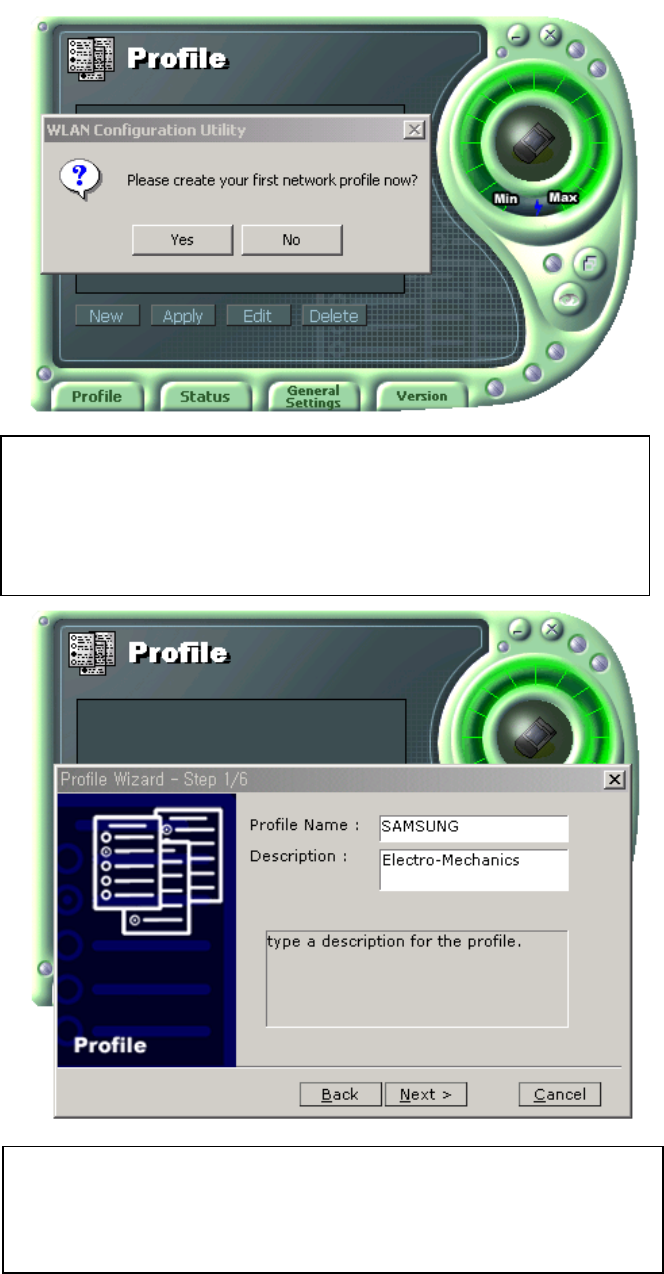
43
8.2 Installation Procedure
First time use of WLAN on your computer needs the following settings.
1. Insert your WLAN card. After clicking on the icon, which is found
at the right bottom your computer screen, “Please create your first
network profile now” window will appear. Click ‘Y’ button for yes
and the following window will appear.
2. Input a profile name in Profile Name and description for you
r
p
rofile name in Description and click the NEXT button, the following
window will appear.
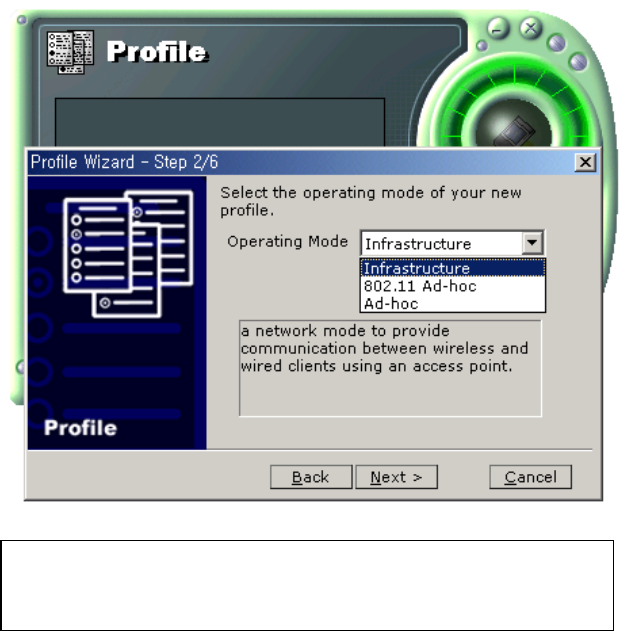
44
- Infrastructure Network is the structure that the communication between Wired LAN and Wireless
LAN is feasible. Wireless client is possible to access to the other Network (include Internet) via
Access Point.
- Ad-hoc/802.11Ad-hoc Network support the communication among Wireless clients. Due to the
support of communication among Wireless equipment, Ad-hoc Network doesn’t need Access
Point. (cf. 802.11 ad-hoc is satisfied with the 802.11 specification)
3. Select the Operating Mode to use and click the NEXT button.
Default operating mode is Infrastructure.
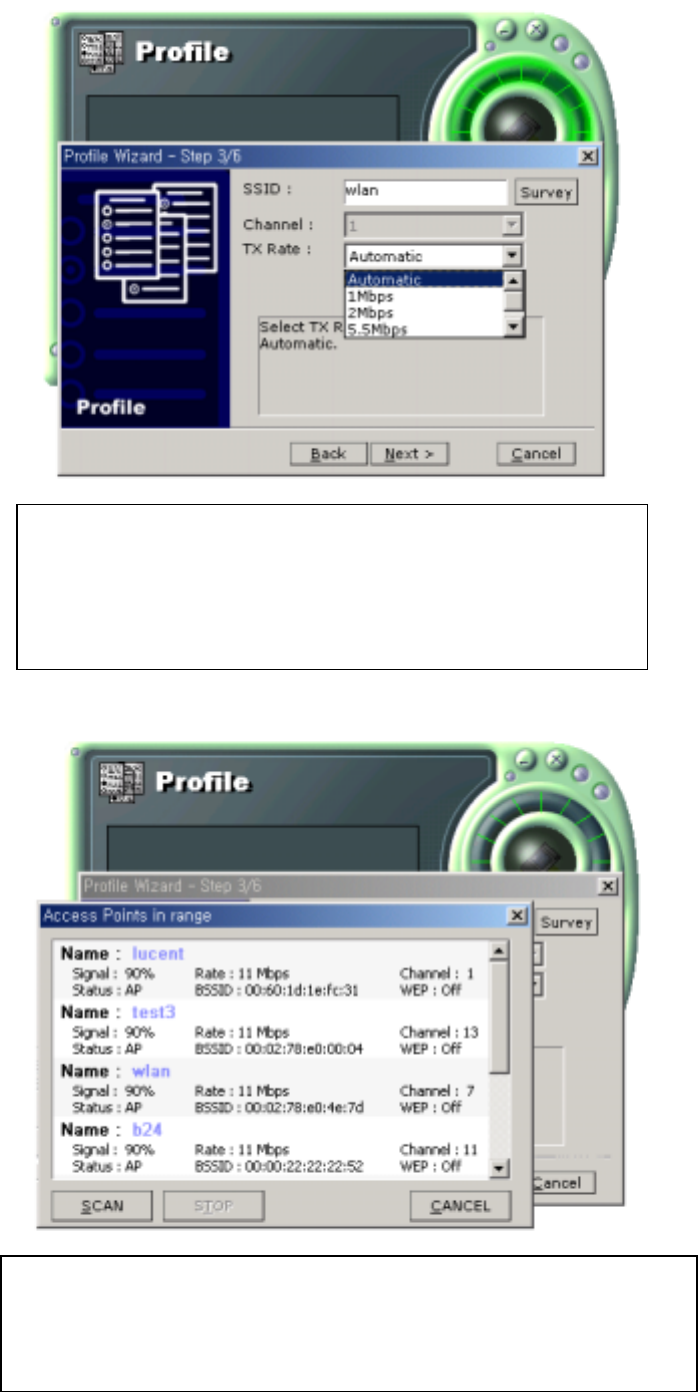
45
4. Enter the SSID (Max 32 characters) of AP to be used in SSID.
If you are not sure which SSID to use, click on Survey and refer
to 4.1. Select the TX Rate for your WLAN card and click the
Next button.
4-1. If you clicked on the Survey, the above window will appear showing
you Access Points or Stations (Ad hoc) that are able to connect now.
Select the AP that has the highest signal to use as an SSID.
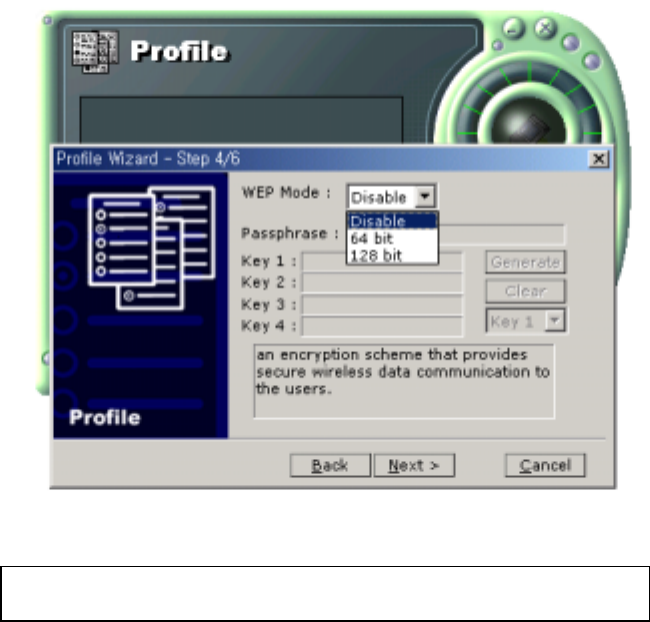
46
- WEP Mode
!"This is security tool to protect your DATA from unauthorized users.
!"To use the function of WEP, The WEP key settings for client must be same to that of AP
in the Infrastructure Mode, and the WEP key settings must be same for all clients in the
Ad-hoc/802.11Ad-hoc Mode.
5. Select the WEP Mode and Click the Next button.
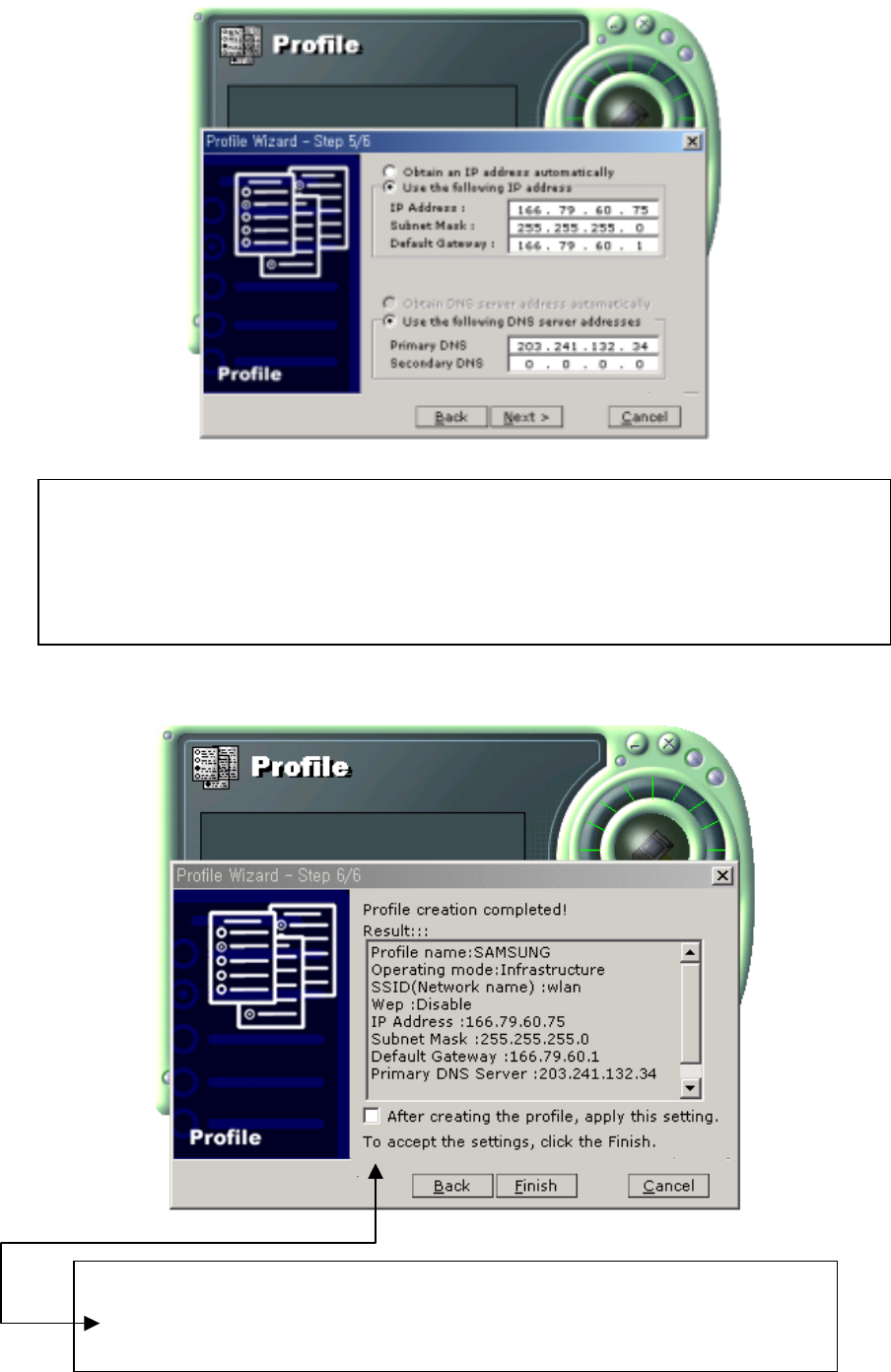
47
6. Enter a valid IP address. IP address can be allocated automatically. (cf. it is limited to users
who use the DHCP server or ADSL connection). As only checked in “Manage TCP/IP
together with Profile”, IP address can be controlled in the Profile. This menu does not appear
under MS Windows NT. Click NEXT to see the following window.
7. Showing you the settings selected so far. Click the Finish button.
Check on this box. It will work on the system after clicking the Finish button.
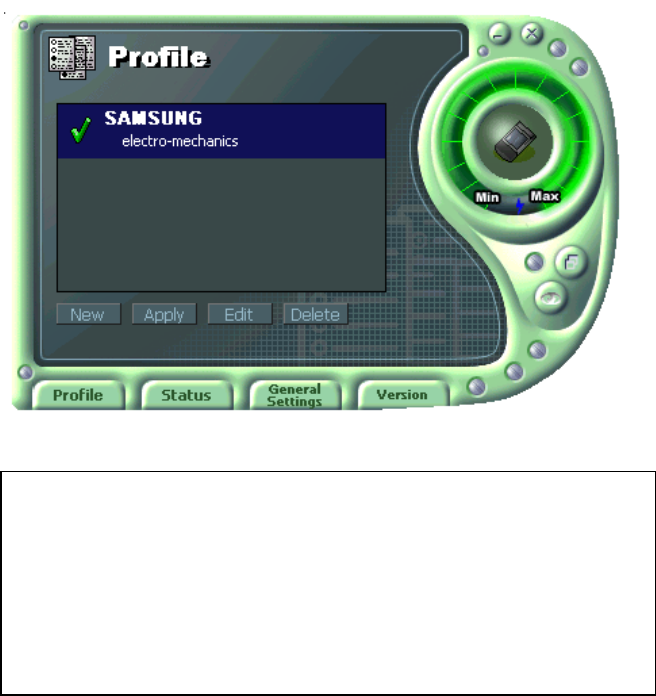
48
8. Click the Profile name shown in the above window click the Apply
button. The settings will be over. If the IP address entered in the
system settings is different than the IP address selected under
profile name, system IP settings will be changed without rebooting
your system.
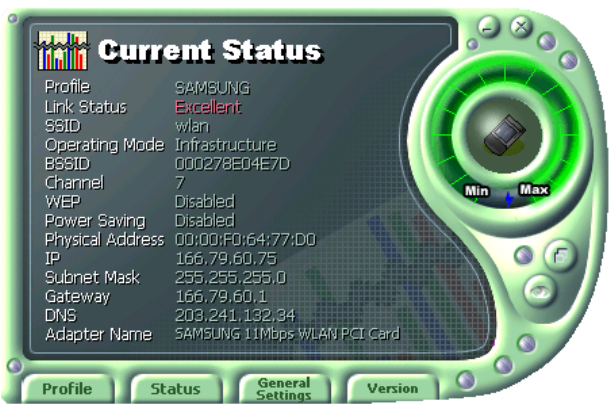
49
9. The main configuration of Program
During the installation of your SAMSUNG WLAN Card, configuration utility is also installed. You
can see the icon at the right bottom of your screen. Double clicking that icon will show you the
screen as shown below.
The following describes the meanings of variables shown in the WLAN configuration.
Profile: The arbitrary designation by user. It is the profile name to distinguish each Profile. So
when you set the Profile, you would better choose the name that can send the contents it has.
Link Status: Link Status shows you a client connection state with AP (In Infrastructure mode) or
with other clients (In 802.11Ad-hoc Mode).
SSID: It represents the name of a group consisting of WLAN users only. It is also called ESSID.
Operating Mode: There are three Modes. Infrastructure Mode (the connection among clients
through an AP), 802.11Ad-hoc/Ad-hoc Mode (direct connection among clients)
BSSID: It shows the Physical Address of WLAN card inserted in AP in the Infrastructure Mode
and the Random Generation value in the 802.11 Ad-hoc Mode.
Channel: It shows channel number in use for communication between AP and client or among
clients. When the Network Mode is set to the Infrastructure or 802.11Ad-hoc Modes, it searches a
50
channel automatically. But when the Network Mode is set to the Ad-hoc, all clients must use he
same channel to communicate with each other.
WEP: Security tool to be used for encryption/decryption of data to be exchanged between clients
or between clients and AP. It denies the authorized access to network if WEP is enabled.
Power Saving: The Power Saving Mode that prolongs the life of battery.
Physical Address: It is the Physical address of WLAN card being used by user. This is also the
MAC address of the WLAN card.
IP Address: Address used to send data from one computer to another to create the network of
several computers. IP address is unique for every network card installed on a computer to identify it
from other computers.
Subnet Mask: It is an address that enables along with an IP Address to share a network Address
within the LAN of company.
Gateway: The network point playing a role as a gateway to enter the other network.
DNS: It is the system that transforms the name of an Internet domain to the corresponding IP
Address. IP Address is actually needed to locate a computer/server on the Internet.
Adapter Name: It shows the kind of WLAN card that the user is using now.
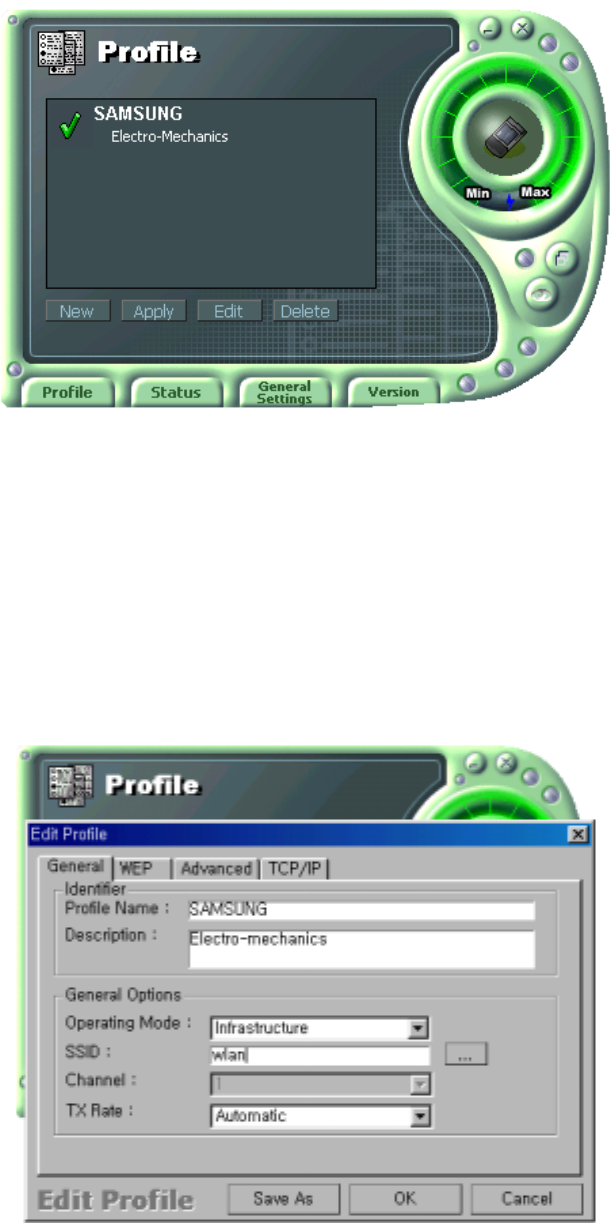
51
The following description is the fundamental installation of WLAN Card. (It is operated by four
buttons on the bottom of Utility)
9.1 Profile
9.1.1 The ‘New’ button
Clicking the New button, you can add or make a new Profile.
(Refer to ‘The Program for setting Magic LAN’ in the Chapter 8)
9.1.2 The ‘Apply’ button
Select and click a Profile to be used, then the saved or modified profile settings will be used for
configuring your WLAN card.
9.1.3 The ‘Edit’ button
Clicking the Edit button or the Profile name that was created previously, you can modify that
Profile.
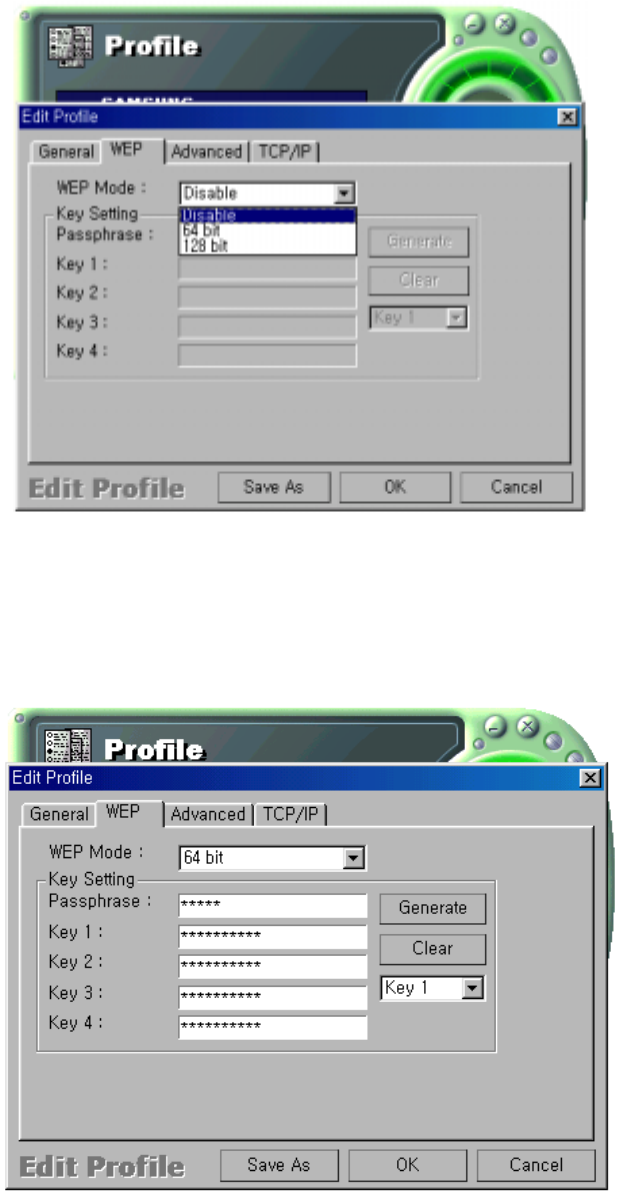
52
- Click the WEP button to set the security.
.
1. First of all, select the ‘64 bit’.
2. Input a certain value (ex. test1 etc) in the ‘Passphrase’ and click the Generate button. Then it
will make four values of keys automatically.
3. Then you set the same value to the WEP of AP. (cf. If you use the WLAN made from other
company, you must set the same values in the four keys)
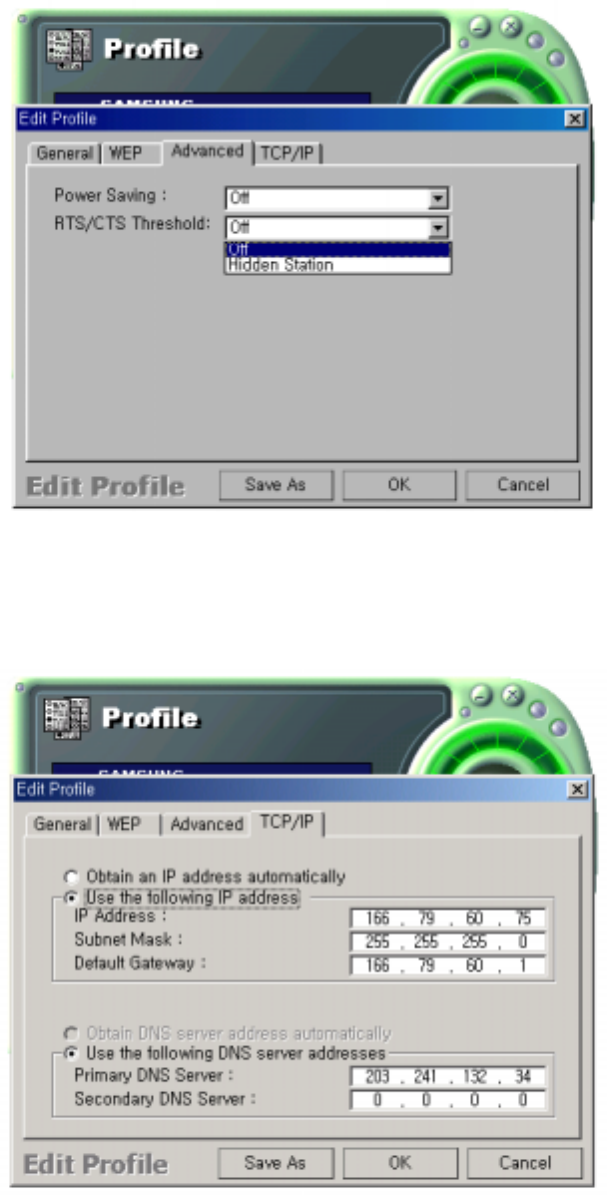
53
- You can set the ‘Power Saving’ and ‘Threshold’ with clicking the Advanced button.
1. Power Saving Mode saves the Battery. (cf.. it can give a lowing of efficiency
according to 802.11Specification)
2. RTS/CTS Threshold Mode is better used in the place surrounded with much RF
interference.
- Click the TCP/IP to input the IP directly or receive IP automatically.
9.1.4 The ‘Delete’ button
Select a profile and click on Delete button to remove that profile.
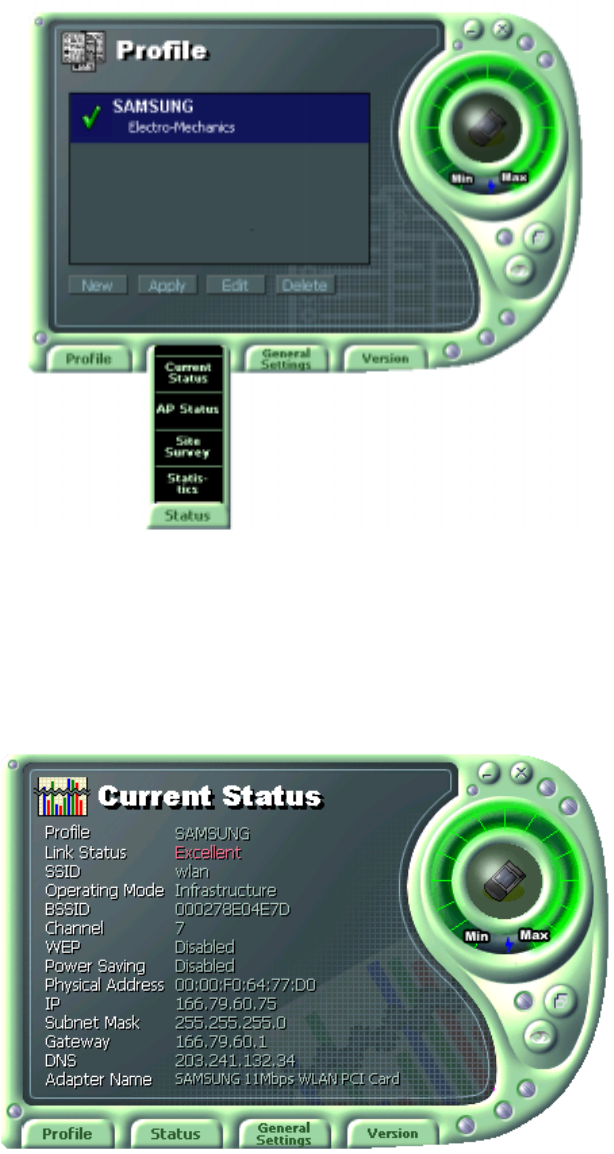
54
9.2 Status
9.2.1 The ‘Current Status’ button
It shows the current state of the WLAN card. (Refer to the ‘ The main configuration of Program’)
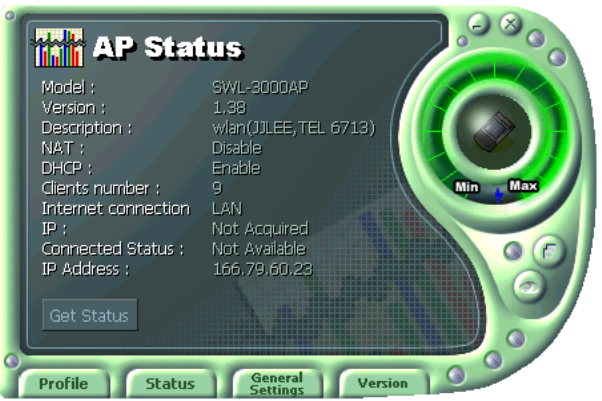
55
9.2.2 The ‘AP Status’ button
It shows the current state of AP. (You can see the IP address changed by the Get Status button)
Model: It shows the name of model.
Version: It shows the version of AP.
Description: It is the name of AP designated by AP manager during AP setup.
NAT: It shows whether the private IP address (NAT server) is enabled or not.
DHCP: It shows whether the DHCP sever is enabled or not.
Clients number: It shows the number of users currently connected with the AP.
Internet connection: It is the connection type with outer network (LAN, ADSL, ISDN etc.).
IP Address: It shows whether the IP address is from DHCP server or NAT server.
Connected Status: In case the connection type with the outside network is of ADSL/CABLE type,
it shows the connection state between AP and ASP service.
IP: It is the IP address of the AP.
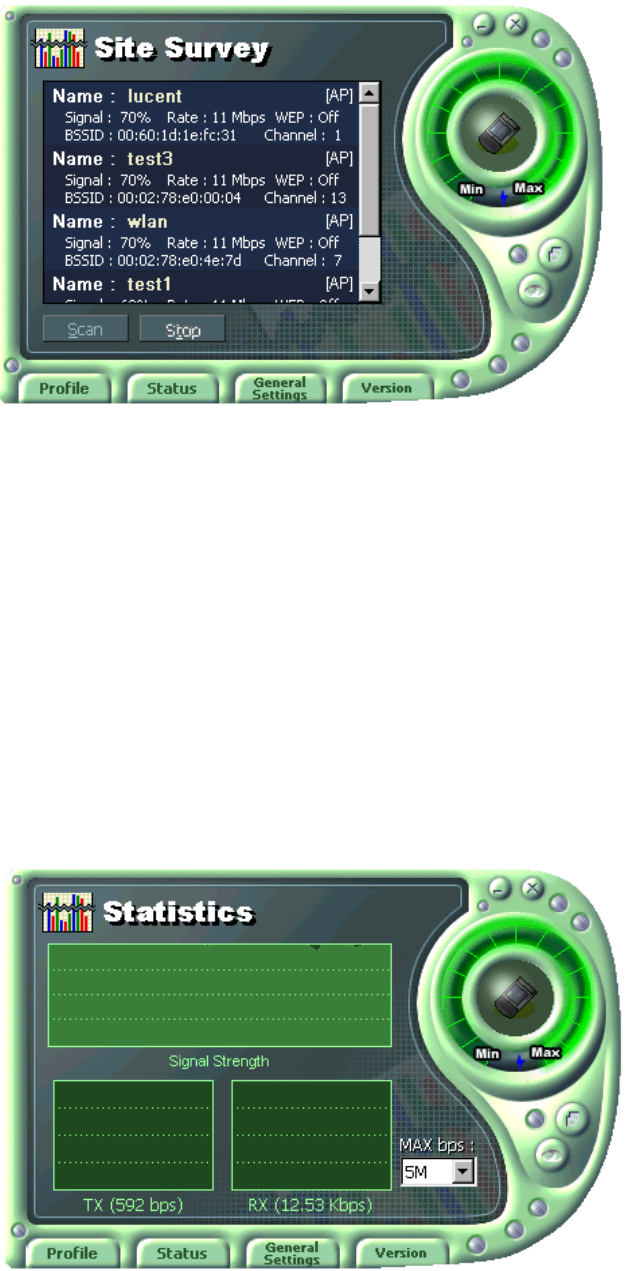
56
9.2.3 The ‘Site Survey’ button
It finds you the AP/Station that are connected currently. (It takes a few seconds to be done)
Signal: It shows the connection state of Stations with AP or Master Station.
Rate: It shows the Tx Data rates.
WEP: It shows security state with the AP.
BSSID: It represents the Physical Address of AP in the Infrastructure Mode and the Random
Generation value in the 802.11 Ad-hoc Mode.
Channel: It shows the currently used channel number.
9.2.4 Statistics
It shows the state of the data transmission. (You can regulate the graph to be see clearly with the
settings of the MAX bps on the right side of bottom)
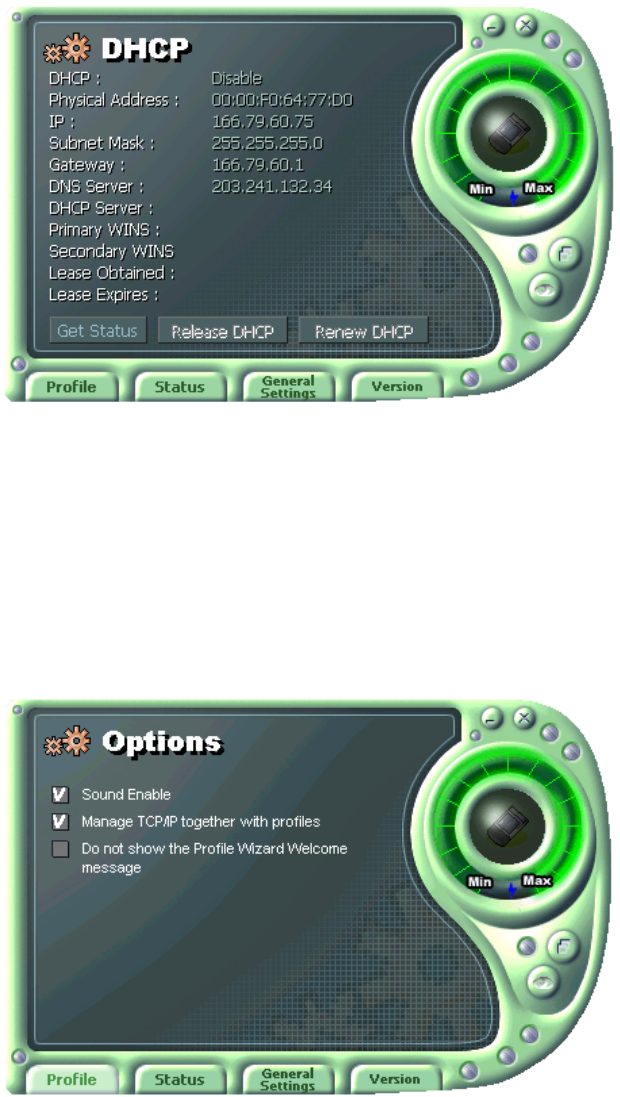
57
9.3 General Settings
9.3.1 The ‘DHCP’ button
- It works when it is enabled.
- The Get Status button shows the updated information obtained from the DHCP server.
- The Release DHCP button releases the IP Address that was received from the DHCP server.
- The Renew DHCP button is for receiving the IP Address from the DHCP server.
9.3.2 The ‘Options’ button
- If you disable the check from the ‘Sound Enable’, you cannot hear the sound whenever you click.
- If you disable check from the ‘Manage TCP/IP together with profiles’, you cannot control TCP/IP
in the utility. You can just modify TCP/IP in the Network Neighborhood.
- If you check the ‘Do not show the Profile Wizard Welcome message’, ‘Welcome message does
not pop up in case of set or add the Profile.
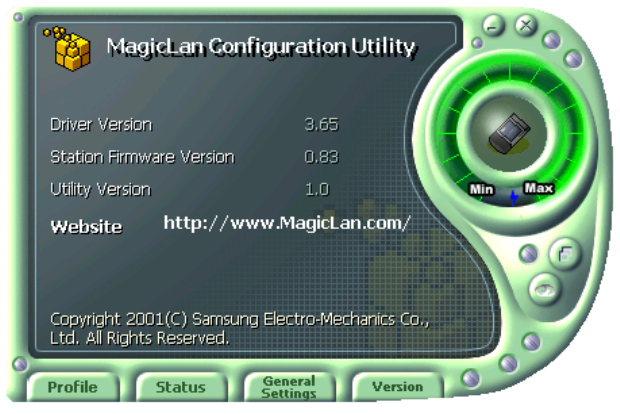
58
9.4 Version
- You can see the Driver and Firmware version for your WLAN card currently in use.
- Click the Website to get more information about WLAN.

59
10. Troubleshooting
To make the installation of SAMSUNG WLAN Card more users friendly, we have
suggested following the installation steps one by one as listed in the section 3 and section 4.
Still you encounter some problems while installing the WLAN Card or you want to confirm
whether your card is installed properly or not, we have listed the procedure for checking the
various components after you have installed the card. In first part of Troubleshooting, we
have suggested the users to check the various properties of the card to check the proper
installation. In second section, we have listed the various problems that you may encounter
during the installation and have also listed the possible solution. Check the first part to
guess the probable reason of unsuccessful installation.
10.1 Procedure to Check the Various Properties of Card after Installation:
For PC Card under Windows 95 (OSR2)/98:
Please check the followings if you encounter some problem while installing the PC card or
your PC card is non-functional.
1. Click on the Control Panel and then on PC Card. Check whether it has PC Card
in one of the sockets or not. If you find SAMSUNG 11Mbps WLAN PC Card in
one of the sockets, it means the card is detected properly. If you see the Yellow sign
of Question-mark (?), the resources are conflicting.
2. Right click on My Computer and the select Properties. Select the Device
Manager and click on the Network Adapter. You will find SAMSUNG 11Mbps
WLAN PC Card 3V/5V if it is installed successfully. If you see the Yellow sign
the resources are conflicting. Click on PC Card and then on PC Card Service, you
can see the status of PC Card. If there are yellow sign either on adapter or PC Card,
please check the followings.
i) Check if your Notebook supports 3.3V Card.
ii) Check if your Notebook has a free IRQ. If not, make an IRQ

60
free by assigning the same IRQ to some devices, for example
COM 1, COM 2 can be assigned same IRQ values.
iii) Check that you have inserted the right card and have installed
the proper driver.
For PC Card under Windows 95/98:
Please check the following if you encounter some problem while installing the PC Card or
your PCI card is non-functional.
1. Click on the Control Panel and then on PC Card. Check whether it has PCI card
in one of the sockets or not. If you find SAMSUNG 11Mbps WLAN PCI Card in
one of the sockets, it means the card is detected properly. If you see the Yellow sign
of Question-mark (?), the resources are conflicting.
2. Right click on My Computer and the select Properties. Select the Device
Manager and click on the Network Adapter. You will find SAMSUNG 11Mbps
WLAN PCI Card if it is installed successfully. If you see the yellow sign the
resources are conflicting. Click on PC Card Socket and then you can see the
PCI/PC Card. If there are Yellow signs either on PC Card or PCI card, please
check the followings.
i) Check that you have installed the proper driver.
ii) If the above i) and ii) are already checked and are set properly, uninstall
the driver, remove the PCI card and reinstall the driver.
For PC Card under Windows NT:
Important: Some notebook computers for Win NT 4.0 operating system that do not
support 3V cards will not install your PC Card successfully. You are advised to install the
driver for PC Card Controller available from set manufactures or install the CardWizard
program that will enable the notebook computers supporting 5V cards to support 3V
cards also and will install your PC Card successfully.

61
Please check the followings if you encounter some problem while installing the PC Card or
your PC Card is non-functional.
1. Check the
Windows NT Diagnostics. You should find out whether there is any
conflict in the resource allocation or the I/O address, IRQ allocations. If you
find that the IRQ,I/O addresses are already assigned to some other devices, you
must change that value. I/O address needs 40h byte length.
2. Event viewer will show you about the events such as PC Card, swld11 (driver
name) and the status. If you find the Red or Yellow sign, there is some problem.
Please refer to the Troubleshooting at the end of the manual.
3. Click on the Control panel. Double click on the PC Card. You will see
SAMSUNG 11Mbps WLAN Card. Double clicking on that will show you the
Card Information, driver name and the driver file. You must confirm the name
of the driver and the driver file as “swld11” and “swld11.sys”. If you do not find
the names as we listed before, there are some problems and the driver is not
installed properly. Reinstall the driver.
Note: Check the PnP BIOS setup menu and select no in case of the WLAN Card
installation.
For PCI Card under Windows NT:
Please check the following if you encounter some problem while installing the PC Card or
your PCI card is non-functional.
1. Check the
Windows NT Diagnostics. You should find out whether there is any
conflict in the Resource allocation or the I/O Base address allocation. If you find
that the I/O port address is already assigned to some other devices, you must change
that.
2. Event Viewer will show you about the events such as PC Card type i.e. PC
Card or PCI, driver file swldpc11 and the status. If you find the Red or Yellow
sign, there is some problem.
3. Click on the Control panel. Double click on the PC Card. You will see

62
SAMSUNG 11Mbps WLAN PCI Card. Double clicking on that will show you the
Card Information, driver name and the driver file. You must confirm the name of
the driver and the driver file as “swld11” and “swld11.sys”. If you do not find the
names as we listed before, there is some problems and the driver is not installed
properly. Reinstall the driver.
10.2 Probable Symptoms and their Diagnosis:
This section lists the problems you may encounter during the installation of your PCI or PC
Card.
Solving Problems.
Symptom Diagnosis
The system tray wireless monitor is always red. Make sure that all the clients have the same SSID.
Set all clients to the same wireless channel in case of
Ad-hoc network mode.
Make it sure that you are with in the range of an
Access Point (AP). If your PC can’t be associated
with any AP, it cannot communicate with other
clients.
If you cannot connect to one of the clients in the
network.
Make it sure that all clients are up and are running
with a blue taskbar icon.
Make it sure that the client that you want to
communicate with is within the range of an AP.
Make sure that your TCP/IP is set properly and
correctly.
The NT event log lists the error: “Server Service
terminated. Not enough Server Storage.”
Reinstall the Windows NT service pack.

63
In Windows NT, there is no wireless monitor icon in
the taskbar or the Samsung Adapter does not
appear in the PC Card Control Panel applet.
Make sure the PC Card device is started as
Automatic in the device applet of the Control
Panel.
Double click on the PC Card icon in Control Panel.
Click on Samsung Adapter and then on the
properties button. It should say the driver started
correctly.
Make sure the drivers were installed correctly. If all
else fails, uninstall drivers and software through
Add/Remove Program, remove the WLAN Card
and reinstall the drivers following the manual.
You cannot connect to some computers in the
Network Neighborhood.
Make sure a resource is shared among all computers
connected to the same network.
Click on OK on the MS Networking login box and
OK on the following domain error.
If you cannot share a device in NT, you may need to
reinstall the NT service pack.
You may wait for several minutes for all of the PCs to
appear.
In case of the Windows NT, if there is no sound after
you insert the Wireless LAN card.
You must check the resources of the sound card
driver. If the resources are conflicting with
Samsung Wireless (PCI/PC Card) LAN Card
driver, you must change the resources.